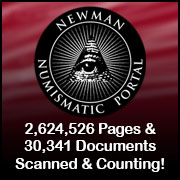
About UsThe Numismatic Bibliomania Society is a non-profit association devoted to the study and enjoyment of numismatic literature. For more information please see our web site at coinbooks.org SubscriptionsThose wishing to become new E-Sylum subscribers (or wishing to Unsubscribe) can go to the following web page link MembershipThere is a membership application available on the web site Membership Application To join, print the application and return it with your check to the address printed on the application. Print/Digital membership is $40 to addresses in the U.S., and $60 elsewhere. A digital-only membership is available for $25. For those without web access, write to: Charles Heck, Treasurer AsylumFor Asylum mailing address changes and other membership questions, contact Chuck at this email address: treasurer@coinbooks.org SubmissionsTo submit items for publication in The E-Sylum, write to the Editor at this address: whomren@gmail.com
BUY THE BOOK BEFORE THE COINSale Calendar
|
- WAYNE'S WORDS: THE E-SYLUM JULY 12, 2020
- NEW BOOK: THE CLASSIC GRAZ PFENNIG
- NEW BOOK: THE COINAGE OF TRIPURA
- BOOK REVIEW: U.S. CLASSIC GOLD COINS OF 1834-1839
- BOOK REVIEW: PHILIPPINE MEDALS & TOKENS, 3RD ED.
- BOOK REVIEW: OTIS KAYE
- BOOK REVIEW: PLEASE IGNORE OUR TIME MACHINE
- GREG BURNS NAMED TAMS JOURNAL EDITOR
- NNP SYMPOSIUM ADDS THIRD DAY
- BUGERT 1878-S HALF DOLLAR CENSUS ON NNP
- COINS 'TOO IMPORTANT FOR THE PUBLIC TO HOLD'
- NOTES FROM E-SYLUM READERS: JULY 12, 2020
- GEORGE T.MORGAN'S PROPOSED GOLD UNION
- MORE ON THE COVID-19 COIN SHORTAGE
- OUR CASH-FREE FUTURE IS GETTING CLOSER
- CORONAVIRUS UPDATES: JULY 12, 2020
- HOW WELL WE ARE FIGHTING COVID-19?
- VOCABULARY TERM: METAL CLEANING
- ROBERT SNEIDER (1841/2-1917)
- COINS PEDIGREED TO NUMISMATIC AUTHOR A. M. SMITH
- FRENCH REVOLUTION BICENTENNIAL STAMPS
- NUMISMAGRAM MEDAL SELECTIONS: JULY 2020
- PORTABLE ANTIQUITIES SCHEME HITS 1.5M OBJECTS
- DETECTORISTS FIND ROMAN COINS AT RACECOURSE
- MORE ON THE AYLESBURY ABOLITION OF SLAVERY TOKEN
- 1837 R. L. BAKER SODA WATER TOKEN OFFERED
- PENNELL'S CRUIKSHANK BANK RESTRICTION DONATION
- NOTE HELPS AUSCHWITZ SURVIVOR TRACE LIBERATOR
- BANK OF IRELAND'S NEW POLYMER £20 BANKNOTE
- COUNTERFEIT MONEY RING BUSTED IN VIETNAM
- LOOSE CHANGE: JULY 12, 2020
Click here to access the complete archive
Click here to unsubscribe (scroll down)
To comment or submit articles, reply to whomren@gmail.com
Content presented in The E-Sylum is not necessarily researched or independently fact-checked, and views expressed do not necessarily represent those of the Numismatic Bibliomania Society.
WAYNE'S WORDS: THE E-SYLUM JULY 12, 2020
 New subscribers this week include:
Dr. Earl D. Honeycutt, courtesy of Ken Berger;
Joe Linzalone, courtesy of Bob Van Arsdell;
Anish Mehta,
Steven Peterson,
J. Stuart Rader, and
Jacob Yanovich.
Welcome aboard! We now have 6,143 subscribers.
New subscribers this week include:
Dr. Earl D. Honeycutt, courtesy of Ken Berger;
Joe Linzalone, courtesy of Bob Van Arsdell;
Anish Mehta,
Steven Peterson,
J. Stuart Rader, and
Jacob Yanovich.
Welcome aboard! We now have 6,143 subscribers.
Thank you for reading The E-Sylum. If you enjoy it, please send me the email addresses of friends you think may enjoy it as well and I'll send them a subscription (but let me know if they are located in the European Union). Contact me at whomren@gmail.com anytime regarding your subscription, or questions, comments or suggestions about our content.
This week we open with two new books, four reviews, a new TAMS Journal editor, and updates from the Newman Numismatic Portal.
Other topics this week include the money art of Otis Kaye, 1978-S Half Dollars, George Morgan's $100 gold Union, engraver Robert Sneider, Roman coins found at a racetrack, an early South Carolina token, and the Bank of Ireland's new polymer banknote.
To learn more about Philippine medals and tokens, missing gold coins, Peratrovich dollars, the COVID-19 coin shortage, coin show updates, metal cleaning, shot peening, French Revolution Bicentennial stamps, Roman 'grots', the Icelandic Phallological Museum, Kazakhstan's Order of the Golden Eagle, coins too important for the general public to hold, and Bermanian tickle-tokens, read on. Have a great week, everyone!
Wayne Homren
Editor, The E-Sylum
NEW BOOK: THE CLASSIC GRAZ PFENNIG
A new book published in German catalogs the classic Graz pfennigs. Here's the information from the publisher's site. -Editor
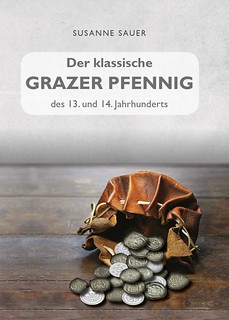 Condition: NEW, hardcover | Abbreviations
Condition: NEW, hardcover | Abbreviations
Catalog number: ISBN 978-3-200-06896-4
The classic GRAZER PFENNIG of the 13th and 14th centuries
This book deals with the Styrian coinage and the development of the Graz Pfennige in the late Middle Ages. After a detailed historical overview with regard to the minting of this period, the question of the individual mints and the metrology are dealt with.
The extensive list of finds also provides an overview of all published finds with a share of Graz.
Each and every one of the 143 coin types is highlighted and commented on, with the main focus on the image viewing and its interpretation. This also allows a large number of Graz pennies to be placed in another than the previously assumed time frame.
The final type catalog essentially shows the different motifs and their variants. An overall picture could be reconstructed for most types, which is presented in the type catalog both as a photo and in the form of a drawing. This is intended to provide easier access to the often poorly developed Graz pennies.
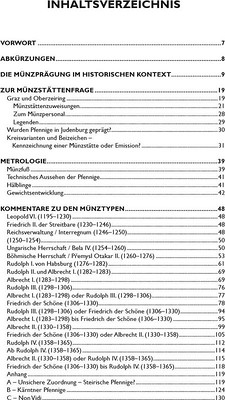

2020, 295 pages, hardcover, format 34x21.6x2.3, 1.5kg
ISBN 978-3-200-06896-4
Please note that the shipping costs for books are calculated by weight.
For more information, or to order, see:
Sauer 2020 Austria The classic Graz Pfennig Graz NEW, hardcover
(http://46.22.41.250/sauer/item.php?id=299&lang=en)
To read the CoinsWeekly article, see:
Graz Pfennigs
(https://coinsweekly.com/graz-pfennigs/)

NEW BOOK: THE COINAGE OF TRIPURA
Here's a new book on the coins of Tripura, a state in northeastern India. -Editor
 Nicholas G. Rhodes & Shankar Kumar Bose's The Coinage of Tripura: With Notes on the Seals, Orders, Decorations and Medals of the State: Revised and Updated
Nicholas G. Rhodes & Shankar Kumar Bose's The Coinage of Tripura: With Notes on the Seals, Orders, Decorations and Medals of the State: Revised and Updated
Nicholas Rhodes (Author)
Shankar K. Bose (Editor)
Synopsis
The issue of coins is naturally associated with the economy of the concerned place and the role of coins in the reconstruction of economic history is obvious.
ABOUT THE AUTHOR
Nicholas Rhodes was born in London. He studied mathematics at Cambridge University, and is an Actuary by profession. He is a keen numismatist and is a specialist on the coinages of Tibet, Nepal, Bhutan, Sikkim and North East India. He has written widely on the subject.
That's probably the least-helpful book synopsis you'll ever read. But I'm sure it's a fine book. -Editor
For more information, or to order, see:
Nicholas G. Rhodes & Shankar Kumar Bose's the Coinage of Tripura: With Notes on the Seals, Orders, Decorations and Medals of the State: Revised and Updated
(https://www.bagchee.com/books/BB129655/nicholas-g-rhodes-shankar-kumar-boses-the-coinage-of-tripura-with-notes-on-the-seals-orders-decorations-and-medals-of-the-state-revised-and-updated)
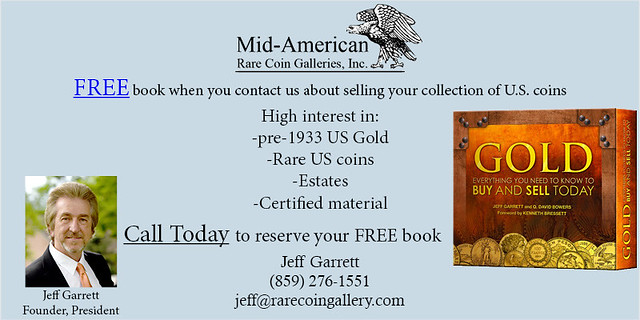
BOOK REVIEW: U.S. CLASSIC GOLD COINS OF 1834-1839
Doug Nyholm edits The Mint Master, the official publication of the Utah Numismatic Society. In the July 2020 issue he published his review of Daryl Haynor's new book on Classic Gold. With permission, we're republishing it here. Thanks! -Editor
CLASSIC GOLD COINS 1834-1839
Daryl J. Haynor
 The new book on classic gold finally arrived at my door last
week and it is a fantastic work. Touted as the first major
work on the subject of these sometimes overlooked coins, it
is certainly a very complete study. These coins were only
struck for six years consisting of a quarter and half eagle. This period was during a tumultuous time in our history
and these coins have been mostly collected for type while
only serious numismatists have attempted a date/mint set.
The new book on classic gold finally arrived at my door last
week and it is a fantastic work. Touted as the first major
work on the subject of these sometimes overlooked coins, it
is certainly a very complete study. These coins were only
struck for six years consisting of a quarter and half eagle. This period was during a tumultuous time in our history
and these coins have been mostly collected for type while
only serious numismatists have attempted a date/mint set.
This study looks at each issue but also delves into the various dies and die states that can be identified. I personally
enjoy books that also go beyond just individual coins information and include history which this book does very well. It explains not only the history but the financial state of the country and goings on at the mint itself. Daryl does an excellent job of addressing these items and spends the first 81 pages in his book on these subjects. Chapters include:
- The Early United States Money System
- The Second Bank War
- William Kneass Chief Engraver
- Mine to Mint
- Gold indemnity payments
And several other subjects.
The integral part of the book covers Classic gold with extensive data on each issue which includes all the different die varieties. Each is identified by a 'HM-#” which stands for Haynor/McCloskey.
Each date is extensively covered, for example the 1836 quarter eagle contains a total of 27 pages profusely illustrated by high quality photos. Every variety is detailed with excellent descriptions, estimated survivors, by condition and also details previous auction records. Finally, all proof varieties and finest knowns are detailed. The book consists of 352 pages in full color on glossy pages and is hard bound. The pre-publication price has expired, and the list price is $95 available from Wizard coin Supply. This is definitely a book for every advanced numismatic library or anyone interested in early U.S. gold.
For more information, or to order, see:
United States Classic Gold Coins of 1834-1839
(https://www.wizardcoinsupply.com/united-states-classic-gold-coins-of-1834-1839)
To read the earlier E-Sylum articles, see:
NEW BOOK: U.S. CLASSIC GOLD COINS OF 1834-1839
(https://www.coinbooks.org/v23/esylum_v23n12a02.html)
BOOK REVIEW: U.S. CLASSIC GOLD COINS OF 1834-1839
(https://www.coinbooks.org/v23/esylum_v23n26a07.html)
BOOK REVIEW: PHILIPPINE MEDALS & TOKENS, 3RD ED.
Ken Berger submitted this review of the new edition of Earl Honeycutt's book on Philippine tokens and medals. Thanks! -Editor
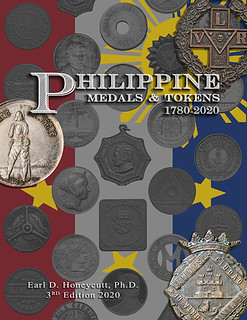 Philippine Medals & Tokens 1780-2020, 3rd Edition
Philippine Medals & Tokens 1780-2020, 3rd Edition
Book Review by Dr. Kenneth J.E. Berger
The other day I received in the mail Dr. Earl D. Honeycutt's newest edition (3 rd ) of his book, Philippine Medals & Tokens 1780-2020. I can honestly say that I am greatly impressed.
The first thing I immediately noticed was that this edition, unlike the first two, is not spiral bound. Instead, this edition uses what is known as perfect (or paperback) binding. This alone is a vast improvement. Having used his previous editions, I can state that although spiral bound books can lie flat, they do not hold up to extensive use and the covers and pages eventually come loose and separate. Complementing this improved binding is a well-designed glossy cover in full color.
The biggest improvement, however, is that the pictures of all the medals and tokens are not only much clearer but are in full color! Depicting them in color allows the reader to better appreciate the beauty of many of these medals/tokens. The only further improvement would be to include pictures of the reverses unless they are blank.
This edition has a total of 1882 entries which is 330 more entries than the 2nd edition for an increase of twenty-one percent. Compare this to Aldo Basso's 2nd edition which only numbered approximately 195 entries. Without a doubt, Dr. Honeycutt has become the pre-eminent authority on Philippine medals and tokens For example, although Basso numbers are still being used today, they are rapidly being replaced by Honeycutt numbers.
As with his previous editions, Dr. Honeycutt has once again included estimated values for each of the medals/tokens. How he has been able to accomplish such a feat is nothing short of amazing, especially since very few of them are regularly found for sale or in auctions.
Of course, any work of this magnitude cannot be expected to be perfect and a few formatting and grammatical errors have been found. However, they are so minor that they might not even be noticed by the average reader and, in no way, detract from the quality of the book.
Even if you only collect Philippine coins and/or banknotes, this book will make a nice addition to your library. It would also be of interest to medal and token collectors in general and to historians who have an interest in the Philippines.
The book is available from the author for U.S. $60.00 plus $4.00 P&S within the U.S. The author may be contacted at: Dr. Earl D. Honeycutt, 226 Edgewater Circle, Chapel Hill, NC 27516-4418 or via email: ehoneycutt@elon.edu
To read the earlier E-Sylum article, see:
NEW BOOK: PHILIPPINE MEDALS AND TOKENS, 3RD ED.
(https://www.coinbooks.org/v23/esylum_v23n27a03.html)

BOOK REVIEW: OTIS KAYE
While looking for other things this week I came across a great book I'd missed before on the work on trompe l'oeil artist Otis Kaye; I added it to my growing shelf of books on money artists such as William Harnett and J.S.G. Boggs. It's the catalog from a 2015 exhibit of Kaye's works at a museum in Connecticut. Here's an excerpt from a Wall Street Journal review. -Editor

D'-JIA-VU?' (1937), by Otis Kaye.
Otis Kaye—you've probably never heard of him. Even many art historians do not recognize his name. But “Otis Kaye: Money, Mystery, and Mastery,” a small exhibition here at the New Britain Museum of American Art, shows this eccentric artist, who sold only a few pictures in his lifetime (1885-1974), to be well worth knowing.
The exhibit heralds Kaye as a master of the still-life genre known as trompe l'oeil (which uses hyperrealistic images and shortened perspective to “fool the eye” into seeing the painted objects as real) and a less-successful practitioner of landscape and figurative art. Judging from the 34 works on view, though, there's a reason for that: Kaye seemed to be less interested in the latter kind of paintings. In contrast, he threw his heart into the meticulous, highly detailed, often autobiographical trompe l'oeil pictures, filling them with illusions and allusions. They are spiced with humor, too—sometimes silly, sometimes clever, usually sardonic.
Much about Kaye remains unknown. Even his birth name and that of his father, a German immigrant who settled in northern Michigan in the early 1880s, are uncertain. Around 1904, Kaye moved to Germany with his mother, studied engineering and draftsmanship, and then came back to the U.S., where he worked as an engineer, ending up in Illinois.
Sometime in the 1920s he began to paint, focusing on the subject that would course through virtually all of his output: money. At first, he emulated the great American trompe l'oeil painters of the 19th century, such as William Harnett and John Frederick Peto, making comparatively simple compositions of paper money and coins.
But as his own fortunes changed, Kaye created more complex, layered works that convey his thoughts on the stock market, luck, morality, corruption and capitalism. The title of one work, from 1940, says it all: “Face It, Money Talks.”
Money talks loudest, perhaps, in Kaye's “D'-JIA-VU?” (1937), the painting that first interested James M. Bradburne, the departing director of the Palazzo Strozzi in Florence, who curated this exhibition with Geraldine Banks, research coordinator for the Otis Kaye Family Trust. In 2010, the Palazzo Strozzi presented “Art and Illusion,” a survey of trompe l'oeil from antiquity to the present that included “D'-JIA-VU?” It set Mr. Bradburne “on the trail” of Kaye.
Though Kaye is an unrestrained jokester, he is a learned one—dropping in ancient coins and early American ones as well as common nickels and pennies. “Seasons Greetings II” refers to “C. Dickens” and includes a letter from Solomon to Shadrach, Meshach and Abednego, the biblical characters saved from a fiery death by an angel. Nearly every painting is loaded—possibly overloaded—with similar examples.
For even the closest viewers of his works may miss some meanings. Kaye, a semirecluse in his later years, painted for himself. A critic of his times whose messages are still relevant, he made very original works that have received scant exposure and demand more decoding. This exhibit, Kaye's first in a museum, is a welcome step in that direction.
To read the complete article (subscription required), see:
Review of 'Otis Kaye: Money, Mystery, and Mastery' at the New Britain Museum of American Art
(https://www.wsj.com/articles/review-of-otis-kaye-money-mystery-and-mastery-at-the-new-britain-museum-of-american-art-1426112375)
I found a copy at the Hamilton Book site at a great discount from the original $25 price. -Editor
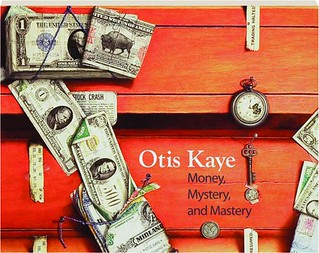 OTIS KAYE: Money, Mystery, and Mastery
OTIS KAYE: Money, Mystery, and Mastery
J.M. Bradburne & G. Banks
Exhibition catalog. This exhibition delves into the intricate details and mysteries of Kaye's life and works. A beautiful resource for anyone seeking to learn more about trompe l'oeil and this fascinating artist. Fully illustrated in color.
Format: Paperbound
Pages: 187
Publisher: New Britain Museum of Ame
Size: 11x8½ inches
ISBN: 9780972449755
Item #: 2786168
For more information, or to purchase, see:
OTIS KAYE: Money, Mystery, and Mastery
(https://www.hamiltonbook.com/otis-kaye-money-mystery-and-mastery-paperbound)
For more information on the exhibit, see:
Otis Kaye: Money, Mystery, and Mastery
(https://www.nbmaa.org/exhibitions/otis-kaye-money-mystery-and-mastery)

BOOK REVIEW: PLEASE IGNORE OUR TIME MACHINE
In his blog The Rational Optimist. Frank Robinson reviews the new book by Allen Berman, a.k.a. Alanus I, King of Bermania. With permission, we're republishing it here. Thanks! -Editor
Once traveling with my family through Philadelphia Airport, I encountered an acquaintance, and introduced my little daughter to him as the King of Bermania. I guess it made an impression on her young mind.
Fast forward a dozen years or so. She showed me a draft of her college application essay. About travel broadening one's horizons or something. Mentioning how, in an airport, she'd once met a king. “Ahem, Elizabeth,” I said. “You see, that was actually . . . ”
 Allen Berman. A fellow coin dealer. He also goes by Alanus I, King of Bermania. But that's all in fun. Though it's very elaborate fun. He's held Bermanian fests at coin shows. (Remember those BC [before covid] times when we had coin shows?) Now he's written a book about Bermania, Please Ignore Our Time Machine. He finagled me into buying a copy. At least it was cheaper than on Amazon.
Allen Berman. A fellow coin dealer. He also goes by Alanus I, King of Bermania. But that's all in fun. Though it's very elaborate fun. He's held Bermanian fests at coin shows. (Remember those BC [before covid] times when we had coin shows?) Now he's written a book about Bermania, Please Ignore Our Time Machine. He finagled me into buying a copy. At least it was cheaper than on Amazon.
As its opening explains, Bermania is a (very) small old kingdom somewhere in Eastern Europe; whose name does not actually derive from his own. It seems the land's early inhabitants had a thing for lawn ornaments. One fellow displayed a large wooden bear.
 He became known as the “Bear man.” The rest, as they say, is history (explicated rather more verbosely in the book). And since Renaissance times, hawking “relics” of “the true bear” has been a Bermanian cottage industry.
He became known as the “Bear man.” The rest, as they say, is history (explicated rather more verbosely in the book). And since Renaissance times, hawking “relics” of “the true bear” has been a Bermanian cottage industry.
But Bermania is a very small country indeed. Even smaller than Grand Fenwick. As the author notes, the kingdom avoided Napoleon's armies by hiding behind a tree.
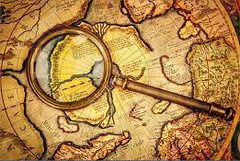 The book is basically a history of Bermania and its quasi-yiddische people. Interwoven with the history of Europe and indeed the rest of the world. For example, few people know that General Tso's chicken is actually more a Bermanian dish than a Chinese one.
The book is basically a history of Bermania and its quasi-yiddische people. Interwoven with the history of Europe and indeed the rest of the world. For example, few people know that General Tso's chicken is actually more a Bermanian dish than a Chinese one.
The stories are amusing. Perhaps not S.J. Perelman hilarious — but amusing. There's mention of “[w]hen the famous flying saucer arrived in 654 A.D.” Note this was the famous one.
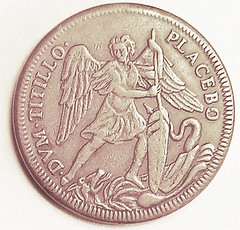 Numismatics is never far from the author's mind. One of the stories concerns what are called royal touch-pieces. This was an actual thing, in pre-modern Britain, whose people believed a certain nasty illness (scrofula) was curable by the King's touch. In connection with these touch ceremonies they minted coin-like “touch-pieces,” often holed and worn on a ribbon around the neck. In the case of Bermania, the malady to be cured was glumness, the monarch administering the remedy of jokes and ticklings. So the Bermanian equivalent of the touch-piece was the tickle-token. Allen had restrikes made; some years ago he gave me one with the request that I carry it in my pocket so eventually he could see what it would look like with natural circulation wear. This was pure Allen. Actually, I didn't know why he couldn't do it himself; but flattered by this royal trust, I have performed it faithfully till the present day.
Numismatics is never far from the author's mind. One of the stories concerns what are called royal touch-pieces. This was an actual thing, in pre-modern Britain, whose people believed a certain nasty illness (scrofula) was curable by the King's touch. In connection with these touch ceremonies they minted coin-like “touch-pieces,” often holed and worn on a ribbon around the neck. In the case of Bermania, the malady to be cured was glumness, the monarch administering the remedy of jokes and ticklings. So the Bermanian equivalent of the touch-piece was the tickle-token. Allen had restrikes made; some years ago he gave me one with the request that I carry it in my pocket so eventually he could see what it would look like with natural circulation wear. This was pure Allen. Actually, I didn't know why he couldn't do it himself; but flattered by this royal trust, I have performed it faithfully till the present day.
The picture shows the worn one from my pocket. Note the angel is not spearing the dragon but tickling it with a feather. As always, I try to thoroughly research my blog posts, so I went to Google Translate to get the technical meaning of the Latin word “placebo.” Google helpfully translated it as “placebo.”
After WWII, like several countries in its neighborhood, Bermania suffered Communist occupation. Then there was the “fig revolt” in the '70s, resulting in a delegation of Bermanian dignitaries dispatched to Bridgeport, Connecticut, their archaic costumes causing them to be initially mistaken for trick-or-treaters confused about the calendar. They may also have been confused about Bermanian royal genealogy. The book unfortunately omits detailing the Bridgeport connection. In any case, these Bermanian emissaries were under the impression that a 14-year-old kid there was the rightful heir to the throne. This was Allen, later Alanus I. (Earlier Bermanian monarchs had much sillier names.)
 Alanus, like all Bermanian kings, has ruled with a light touch. So light in fact that when Bermanian meshuginauts landed on the moon, in 2013, nobody told him. He learned of it later from Edward Snowden.
Alanus, like all Bermanian kings, has ruled with a light touch. So light in fact that when Bermanian meshuginauts landed on the moon, in 2013, nobody told him. He learned of it later from Edward Snowden.
Still and all, humanity has outgrown monarchical government. Bermania should become a democratic republic.
To read the complete article, see:
Tales of Bermania
(https://rationaloptimist.wordpress.com/2020/07/08/tales-of-bermania/)
To read the earlier E-Sylum article, see:
NEW BOOK: PLEASE IGNORE OUR TIME MACHINE
(https://www.coinbooks.org/v23/esylum_v23n13a03.html)
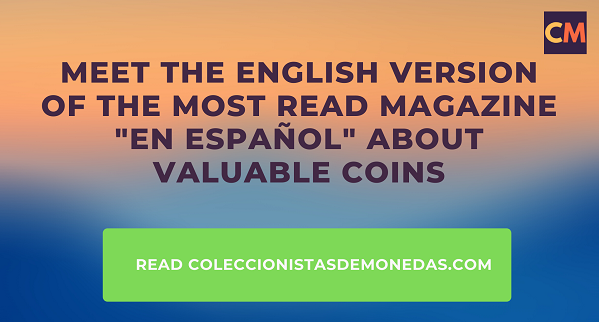
GREG BURNS NAMED TAMS JOURNAL EDITOR
Ernie Nagy of the Token and Medal Society submitted this announcement. Thanks. -Editor
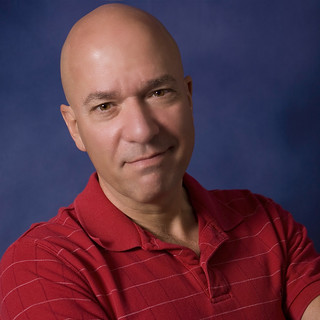 The Token and Medal Society is pleased to announce the appointment of Greg Burns as the editor of the TAMS Journal. The appointment is effective July 1, 2020. Outgoing editor Eric Schena will assist Greg to assure an effective and smooth transition.
The Token and Medal Society is pleased to announce the appointment of Greg Burns as the editor of the TAMS Journal. The appointment is effective July 1, 2020. Outgoing editor Eric Schena will assist Greg to assure an effective and smooth transition.
Greg is currently the editor of The California Numismatist, which has won the ANA's “Best Regional Publication Award” in the Outstanding Club Publications competition multiple times. He will continue to serve as the editor of the California Numismatist.
Please join TAMS in congratulating Greg on the occasion of his being named the editor of the TAMS Journal!
The Token and Medal Society is welcoming new members. Those interested can find information on the membership tab of our website: http://www.tokenandmedal.org/ .
Great choice! Greg does a super job. -Editor
NNP SYMPOSIUM ADDS THIRD DAY
The Newman Numismatic Portal is sponsoring its first symposium at the end of August. NNP Project Coordinator Len Augsburger provided this update. Thanks. -Editor
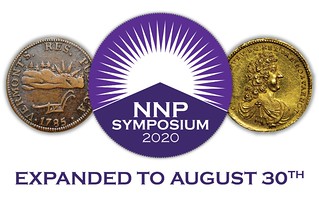 In response to strong demand, the NNP Symposium has added a third day with additional presentations. Now scheduled for August 28 – 30, the NNP Symposium is a Zoom-based online numismatic gathering featuring presentations on a wide variety of numismatic subjects. Scheduled speakers include John Brush, speaking on the D. L. Hansen collection, Greg Rohan, who will discuss the current state of the numismatic market, and a host of others. Participants may also present virtual exhibits on any topic through submitted images and text.
In response to strong demand, the NNP Symposium has added a third day with additional presentations. Now scheduled for August 28 – 30, the NNP Symposium is a Zoom-based online numismatic gathering featuring presentations on a wide variety of numismatic subjects. Scheduled speakers include John Brush, speaking on the D. L. Hansen collection, Greg Rohan, who will discuss the current state of the numismatic market, and a host of others. Participants may also present virtual exhibits on any topic through submitted images and text.
In the last few weeks we've seen strong uptake in the use of Zoom and other conferencing platforms for numismatic meetings. Coin clubs are generally seeing larger audiences than with in-person meetings, as the logistics of attending are greatly simplified. Hosts and attendees are learning Zoom, and, anecdotally, meetings are running more smoothly as users become comfortable with the technology. While many industries have been negatively impacted by the epidemic, numismatics seems to be holding its own – the demand for interesting items hasn't changed, even while the ways we interact with each other are evolving quickly. The NNP Symposium is part of this evolution, freely providing facilitated meeting services.
NNP Symposium attendees should register at the link below, in order to receive the specific meeting notices. There are a small number of presentation timeslots still open, and those wishing to present or host a club meeting may apply here: https://nnpsymposium.org/for-presenters.
Link to NNP Symposium registration:
https://nnpsymposium.org/register
Link to NNP Symposium speaker list:
https://nnpsymposium.org/schedule
To read the earlier E-Sylum articles, see:
NEWMAN PORTAL ANNOUNCES FIRST NNP SYMPOSIUM
(https://coinbooks.org/v23/esylum_v23n24a11.html)
NNP SYMPOSIUM ATTRACTS ADDITIONAL SPEAKERS
(https://www.coinbooks.org/v23/esylum_v23n25a09.html)
THE BOOK BAZARRE
BUGERT 1878-S HALF DOLLAR CENSUS ON NNP
The latest addition to the Newman Numismatic Portal is a census of 1878-S Half Dollars. Project Coordinator Len Augsburger provided the following report. Thanks. -Editor

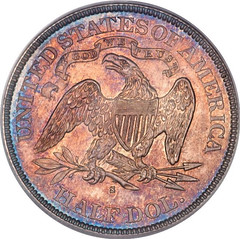
Bugert 1878-S Half Dollar Census Available on Newman Portal
Bill Bugert, working with Randy Wiley, has been a dedicated researcher of the Liberty Seated half dollar (1839-1891) series for over thirty years and has produced a number of works related to these workhorses of American commerce. His ongoing series, A Register of Liberty Seated Half Dollars, consists of five volumes to date, covering all the branch Mint pieces and the Philadelphia coins from 1839-1852. He is currently working on the remainder of the Philadelphia series and will document these in future volumes. In the meantime, he has released two other works, including a census of 1878-S half dollars.
Bill has meticulously followed auction and fixed price listings of the rare 1878-S half, and produced a guide which provides illustrations and detailed pedigree data for 51 separate examples. Bill details a bit of the research process in the introduction: “I was fortunate to have many of what I called 'spies' helping me; these were collectors of the series that reported sightings of 1878-S half dollars. Chief among those was Liberty Seated Collectors Club (LSCC) member Bob Hamby who scouted the southern shows. He would often call me from a coin show bourse floor with details and then send me images. Dennis Fortier and John Frost were also key to helping me. To them and others, I am grateful.” Bill welcomes additional reports as this work is ongoing.
Images: The D. L. Hansen 1878-50c, BB-04 in the Bugert census.
Links to Bill Bugert works on Newman Portal:
https://nnp.wustl.edu/library/booksbyauthor/361
and on the Liberty Seated Collectors website:
http://www.lsccweb.org/BillBugertBooks.php

COINS 'TOO IMPORTANT FOR THE PUBLIC TO HOLD'
Bob Van Arsdell writes:
"The ANA forwarded a State Department form for submitting comments on the restriction of imports of Roman Coins. By the time anyone sees this, it will be too late to react. The following is my submission; I managed to get it in under the deadline."
Here's the text. -Editor
I am a numismatic researcher and published author. My book “Celtic Coinage of Britain” won the 1990 IAPN “Book of the Year” award - the first book by an American author to win the international prize for numismatic literature. I am also the author of the website “Celtic Coinage of Britain - the international site for Ancient British numismatic information - provided free as a public service. I currently publish numismatic research on this site and have published almost 100 works since 1980.
My research and publication stream depend on easy access to Roman Republican coins for study and research. These are extremely common coins and I cannot believe any museum would care to incur the costs for storing and curating all of them.
I am adamantly opposed to limitations on the import, sale and private ownership of these common objects. Such limitations would prevent me from further research, publication and furtherance of knowledge of ancient societies amongst the general American public, not to mention the thousands of people overseas who access the Celtic Coinage of Britain website every month - at no cost.
I urge you to reject further limitations on the import, sale and collecting of ancient coins, and Roman coins, specifically.
Thank you for your consideration,
Robert D. Van Arsdell
Bob adds:
"I think we all need to take a stand.
"The next step will be to outlaw the sale of Colonial Coins as “culturally significant objects” (too important for the general public to hold). The second part's always there in invisible text, you just aren't allowed to see it unless you know the code."
There were two related articles in last week's E-Sylum. One was on this Roman coinage issue; the other was Ron Guth's article on how cultural and political sentiments could lead to changes in U.S. coin designs and perhaps even the ability to collect, research, write about or publish images of coins with out-of-favor designs.
Good intentions can lead down a slippery slope of drastic consequences (usually ones unseen by those ultimately affected until it's far too late to do anything). Here's a non-numismatic section of Ron's article that echoes Bob's point about taking a stand. -Editor
Our current situation reminds me of a version of quotes from the German Lutheran pastor, Martin Niemoeller:
“They came first for the Communists, and I didn't speak up because I wasn't a Communist. Then they came for the Jews, and I didn't speak up because I wasn't a Jew. Then they came for the trade unionists, and I didn't speak up because I wasn't a trade unionist. Then they came for the Catholics, and I didn't speak up because I was a Protestant. Then they came for me, and by that time no one was left to speak up.”
To read Ron's complete blog article, see:
First They Came For The Statues...
(https://numismaticdetectives.com/blog/f/first-they-came-for-the-statues)
To read the earlier E-Sylum articles, see:
HELP SAVE ROMAN IMPERIAL COIN COLLECTING
(https://www.coinbooks.org/v23/esylum_v23n27a13.html)
U.S. COIN DESIGNS: YESTERDAY, TODAY, TOMORROW??
(https://www.coinbooks.org/v23/esylum_v23n27a21.html)

NOTES FROM E-SYLUM READERS: JULY 12, 2020
Shipment of Six Gold Coins Missing
Bob Steinberg writes:
"BE ON THE LOOKOUT FOR THE FOLLOWING SIX GOLD COINS
"We sent an expressmail package to NGC on July 1st---they can track it when it left White River Jct., VT at 6:20 PM on 7/1/20. It "walked away" shortly thereafter as it hasn't been seen since! If you get offered any or all of these coins please contact Matt or Dawn at the WRJ Post Office at: 802-296-3346 or contact Doug Davis or myself.
Central American Republic 1847-CR 1/2 Escudo NGC MS62 (cert # 2767802-004)
Guatemala 1874-P 5 Pesos raw BU
Guatemala 1926 20 Quetzals raw BU
Italy-Naples & Sicily 1767 6 Ducati raw BU
Peru 1854-Lima MB 2 Escudos NGC MS63 (cert # 3807875-007)
Poland 1834 3 Roubles-20 Zlotych raw AU
"We have full insurance on the loss--but it would be nice to catch the person who stole the shipment--last time this happened to us a couple of years ago--they caught the thief in the Tampa post office and he got 18 months in prison!
"Anyway if you get offered any or all of these items from someone who obviously doesn't know what they are---please contact the postal authorities or Doug Davis or myself."
The Post Office number is included above. To reach Doug Davis of the Numismatic Crime Information Center go to: http://numismaticcrimes.org/ . Bob Steinberg can be reached at info@steinbergs.com . -Editor
Ft. Henry Token Attribution Sought

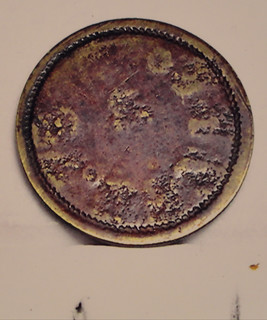
Joe Boling writes:
"I was called by a non-collector in Ohio who is trying to learn something about a “coin” that he acquired many years ago. The local dealers (he says) say it could be worth a lot but they can't help him in attributing or evaluating it. He sent me hard copy photos that I have re-photographed. Of course it is not going to pay off his mortgage.
The owner is not online. I did some Googling and found three Forts Henry- Tennessee (Civil War), Virginia (now West Virginia, French and Indian War), and Ontario (War of 1812, if I am remembering right). There are no doubt more, and this could be made at any time by anyone with a set of letter punches. All three of those forts have current museums. The token's only value might be to a museum if they can connect it with something they have found onsite that has at least a tenuous provenance."
Can anyone help? Joe can be reached at joeboling@aol.com . -Editor
Query: Garbáty Cigarette Company Token(s)

Howard Berlin writes:
"I'm currently writing a non-numismatic book about Jewish memorials in Berlin (yeah, a book about Berlin written by a “Berliner”). One of the 150 or so sites I'm writing about concerns a man named Josef Garbáty who owned a cigarette factory in Pankow, a district in northeastern Berlin. Garbáty's factory had a canteen for its employees where they used tokens, like the 5 Garbáty shown above.
"Does anyone have any info about this token, what it was made of, diameter, etc., and if there were other denominations, or if there were paper chits besides?"
Can anyone help? -Editor
Peratrovich Dollars Not "Released"
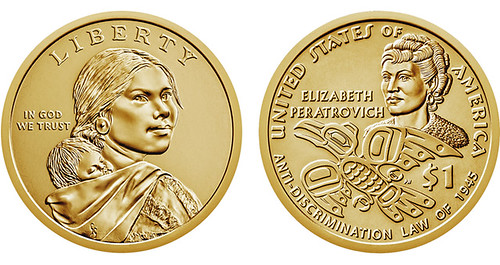
Regarding the Peratrovich dollars, Dick Hanscom writes:
"The dollars have not been released in Alaska. "Released" in my mind means that the banks can order them from the Federal Reserve Bank as they do other coin and currency.
"The Mint has effectively killed the release. No bank is going to contact the mint to order the coins. And no bank is going to be willing to pay postage.
"They have succeeded in perhaps meeting the letter of the State's request, but certainly have killed it by doing it this way. This is not a release, but a bureaucratic dodge to avoid circulating the coin."
I missed that nuance. The push was for banks to order them normally; if that's not an option for them then I agree there's little point. They're not going to incur extra expenses for coins they would distribute at face value. -Editor
Dick adds:
"And I forgot to mention the ordering limits - no more than four boxes. So a bank can only order 1000 coins per day, and if they want more, they have to order over and over again.
"The program was designed to fail."
This is a developing story, so stay tuned. Perhaps some banks will choose to eat the expense and order some anyway to service their customers. -Editor
To read the earlier E-Sylum article, see:
PERATROVICH DOLLARS RELEASED IN ALASKA
(https://www.coinbooks.org/v23/esylum_v23n27a27.html)

GEORGE T.MORGAN'S PROPOSED GOLD UNION
Howard Daniel passed along this gold piece he came across in a July 29, 2020 sale by Noble Auctions in Australia. He had never seen nor heard of it before. -Editor
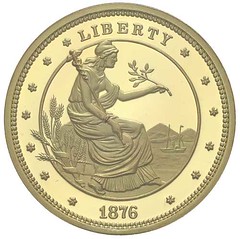
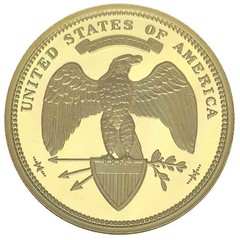
USA, RESTRIKE OF GEORGE T. MORGAN'S proposed gold union or one hundred dollars, 1876, struck in 2012 in .999 fine gold, one ounce (34mm), mintage limit 999. FDC.
Cased in a slab by NGC as Ultra High Relief ultra cameo-gem proof.
To read the complete lot description, see:
USA, RESTRIKE OF GEORGE T.MORGAN'S proposed gold union
(https://www.noble.com.au/auctions/lot?lotno=1567&saleno=124&x=0&y=0)
I had a vague recollection of these being sold to raise funds for the National Numismatic Collection at the Smithsonian, but was quickly frustrated by being unable to find any more information about these anywhere, not even in The E-Sylum archives or the NGC site. I first reached out to NGC Research Director David Lange, who shared my recollection. -Editor
Dave writes:
"I believe they were commissioned by Jeff Garrett to benefit the SI's National Numismatic Collection."
So I next reached out to Jeff Garrett. -Editor
Jeff writes:
"The piece was designed based on a drawing in the George T. Morgan sketch book that resides in the Smithsonian. The drawings are the subject of a great book by Karen Lee who worked at the Smithsonian several years ago. The gold pieces were part of fund raising for the museum thru a licensing contract. These pieces were sold about 10-15 years ago."
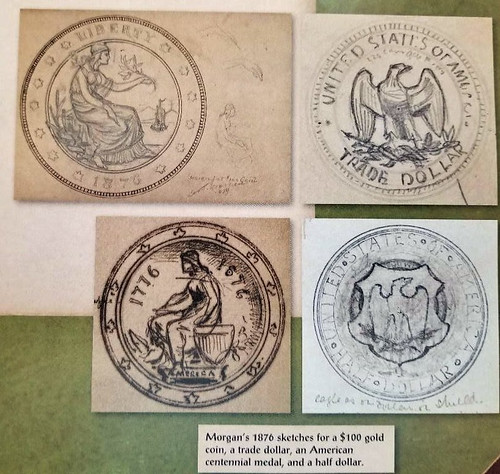
Jeff kindly provided the above sketches. Did any of our readers purchase one of these? Is there an insert with any more information on them? The lot description states that 999 were struck in 2012 in one ounce of .999 fine gold. But who struck them? Who engraved the dies? I wonder if there are any unsold examples available - or were they melted, thus reducing the remaining supply? If anyone can help, please chime in. The lot description called it a "restrike", but these were never struck originally - this piece would more properly be termed a fantasy issue.
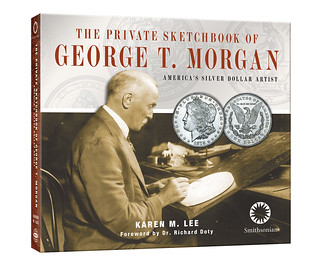 And if you don't already have a copy of The Private Sketchbook of George T. Morgan, America's Silver Dollar Artist,
get one! It's a great book. Below are links to earlier articles about it. Thanks, everyone.
-Editor
And if you don't already have a copy of The Private Sketchbook of George T. Morgan, America's Silver Dollar Artist,
get one! It's a great book. Below are links to earlier articles about it. Thanks, everyone.
-Editor
To read the earlier E-Sylum articles, see:
NEW BOOK: THE PRIVATE SKETCHBOOK OF GEORGE T. MORGAN
(https://www.coinbooks.org/esylum_v15n41a04.html)
BOOK REVIEW: THE PRIVATE SKETCHBOOK OF GEORGE T. MORGAN
(https://www.coinbooks.org/esylum_v15n46a09.html)
DICK JOHNSON COMMENTS ON MORGAN'S PRIVATE SKETCHBOOK
(https://www.coinbooks.org/esylum_v15n52a11.html)
BOOK REVIEW: THE PRIVATE SKETCHBOOK OF GEORGE T. MORGAN
(https://www.coinbooks.org/esylum_v16n02a08.html)
BOOK REVIEW: PRIVATE SKETCHBOOK OF GEORGE T. MORGAN
(https://www.coinbooks.org/esylum_v17n25a06.html)

MORE ON THE COVID-19 COIN SHORTAGE
Here are a few recent articles on the current coin shortage. I haven't seen this much in my area (Northern Virginia), but I don't get out much. -Editor
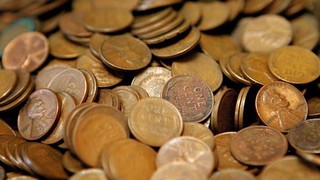 A coin shortage across the country has some Denver businesses pinching pennies.
A coin shortage across the country has some Denver businesses pinching pennies.
"Right now I have no pennies," said Nabi Hossain, a manager at City Bakery Café. "The owner, when he went to the bank to get more pennies, he could only get one roll from the bank."
Her café is hardly alone. Corner stores, restaurants, and gas stations across Denver are reminding patrons that exact change may not be possible. Pennies and nickels are hard to come by at the bank.
The impact is most felt in businesses that still use cash, like small restaurants and thrift stores. But with many payments going touchless, others hardly notice the change.
To read the complete article, see:
A coin shortage across the country has Colorado business owners in a pinch
(https://www.thedenverchannel.com/news/local-news/a-coin-shortage-across-the-country-has-colorado-business-owners-in-a-pinch)
The think tank Cato Institute published a paper on the coin shortage. Here's an excerpt. -Editor
No doubt many find the idea of a coin shortage perplexing. Coins are not consumed; they get passed along from one person to another. In the US, the average coin circulates for around 30 years. How, then, can there suddenly be a shortage of coins? Where have they all gone?
Each year, some coins are lost, discarded, or worn beyond use. They get thrown in a well with a wish; or, dropped down a drain by mistake. To offset the outflow, and keep up with secular growth in demand, the Mint must produce new coins. It issued nearly 12 billion circulating coins in 2019.

Source: This graph is based on data collected by the author from multiple data tables on Coin?News?.net and USMint?.gov. So far, the Mint has not matched its 2019 pace. The global pandemic slowed production at the Denver and Philadelphia branches in March and April. By the beginning of May, the cumulative mintage—that is, the total number of circulating coins produced for the year—was just 4.02 billion, compared with 5.07 billion over the same period in 2019. Both facilities have been operating at full capacity since June 15, though, so that the gap has since fallen to less than 0.06 billion.
But the temporary shortfall in production is only a small part of the problem. A much bigger issue has been the limited extent to which coins have been circulating.
Coins have a much higher weight-?to-?value ratio than cash, which makes them relatively cumbersome to use. Cash goes into wallets, ready to make the next transaction. Coins go into piggy banks, to be deposited or exchanged for cash only occasionally.
Usually, the vast stockpile of coins held by the public is of little consequence because it represents a roughly steady share of the total coin supply. Sure, paper currency circulates more quickly. But peoples' depositing or exchanging coins when their piggy banks get full also results in a relatively steady flow of coins back into the banking system.
Alas, not much has been as usual in the last few months. The global pandemic and corresponding shutdowns have led to a huge slowdown in economic activity. Consequently, the usual flow of coins from our piggy banks into the banking system has dried up. Of course, the flow from the banking system to our piggy banks also dried up, as retailers did not need to request coins from their banks to make change for non-?existent customers.
But as the economy reopened, stores quickly exhausted their existing coin inventories, and then turned to their banks for more. The flow of coins out of the banking system picked up, as coins started piling up in our piggy banks once more. But the flow of coins back into the banking system, from our piggy banks, had not yet restarted. Lacking the usual coin deposits from the public, the banks, in turn, requested coins from the Fed, which requested them from the Mint. With the Mint unable to fill the gap with new coins—and, indeed, falling short of its usual production levels—-a shortage resulted.
The paper goes on to state that "policy decisions have made the shortage much worse than necessary," discussing the continued minting of cents and the historical competition from private mints fulfilling demand when the government fell short. -Editor
The costs of a coin shortage are probably lower today than in the past. We are fortunate to have many alternative payment options. Nonetheless, we should acknowledge the weaknesses of our current system and make improvements if possible. At a minimum, that means scrapping the penny. More fundamental reforms, like permitting competition in coinage, would be better still.
Reviving private coinage is an interesting possibility, but not one endorsed by governments around the world, nor anything being demanded by citizens. In normal times the Mint supplies everything needed, with the usually unwanted cents as a bonus. -Editor
To read the complete article, see:
Where Have All the Coins Gone?
(https://www.cato.org/blog/where-have-all-coins-gone)
See the Coin World article linked below for a statement from the U.S. Mint. Here's an excerpt on Federal Reserve coin distribution. -Editor
The Federal Reserve often shifts circulating coin inventories between contracted armored carrier terminals to alleviate regional shortages, but officials indicate the COVID-19 pandemic presents different challenges.
A temporary coin order allocation at all Federal Reserve Bank offices and Federal Reserve coin distribution locations was imposed by the Fed June 15.
“The COVID-19 pandemic has significantly disrupted the supply chain and normal circulation patterns for U.S. coin,” according to FRBservices.org. “In the past few months, coin deposits from depository institutions to the Federal Reserve have declined significantly and the U.S. Mint's production of coin also decreased due to measures put in place to protect its employees.
“Federal Reserve coin orders from depository institutions have begun to increase as regions reopen, resulting in the Federal Reserve's coin inventory being reduced to below normal levels.
To read the complete article, see:
Mint, Fed team to battle coin shortage brought on by COVID-19 pandemic
(https://www.coinworld.com/news/us-coins/mint-fed-team-battle-coin-shortage-brought-on-by-covid-19-pandemic)
Supermarket chain Kroger has come up with a handy solution. -Editor
Kroger spokesperson Erin Rofles confirmed Friday the grocer will no longer return coin change to customers. Instead, the remainders from cash transactions will be applied to customers' loyalty cards and automatically used on their next purchase.
Customers are also encouraged to 'Round Up' to support the company's Zero Hunger/Zero Waster Foundation.
The upshot? If you go to Kroger, for now you can forget your change purse.
To read the complete article, see:
Kroger cashiers to stop giving customers coin change
(https://www.wistv.com/2020/07/12/kroger-cashiers-stop-giving-customers-coin-change/)
For a nice synopsis of events from Snopes, see:
Did a Nationwide US Coin Shortage Occur in Summer 2020?
(https://www.snopes.com/fact-check/coin-shortage-covid/)
To read the earlier E-Sylum articles, see:
THE COVID-19 COIN SHORTAGE
(https://www.coinbooks.org/v23/esylum_v23n25a11.html)
CORONAVIRUS UPDATES: JUNE 28, 2020 : Mint Response on Coin Shortage (June 22, 2020)
CORONAVIRUS UPDATES: JUNE 28, 2020 : U.S. Coin Shortage Hits Grocers Hard
(https://www.coinbooks.org/v23/esylum_v23n26a12.html)

OUR CASH-FREE FUTURE IS GETTING CLOSER
Len Augsburger passed along this New York Times article on our increasingly cashless society. Thanks. -Editor
 On a typical Sunday, patrons at Julien Cornu's cheese shop used to load up on Camembert and chèvre for the week, with about half the customers digging into their pockets for euro notes and coins.
On a typical Sunday, patrons at Julien Cornu's cheese shop used to load up on Camembert and chèvre for the week, with about half the customers digging into their pockets for euro notes and coins.
But in the era of the coronavirus, cash is no longer à la mode at La Fromagerie, as social distancing requirements and concerns over hygiene prompt nearly everyone who walks through his door to pay with plastic.
“People are using cards and contactless payments because they don't want to have to touch anything,” said Mr. Cornu, as a line of mask-wearing shoppers stood three feet apart before approaching the register and swiping contactless cards over a reader.
While cash is still accepted, even older shoppers — his toughest clientele when it comes to adopting digital habits — are voluntarily making the switch.
Cash was already being edged out in many countries as urban consumers paid increasingly with apps and cards for even the smallest purchases. But the coronavirus is accelerating a shift toward a cashless future, raising new calculations for merchants and enriching the digital payments industry.
Fears over transmission of the disease have compelled consumers to rethink how they shop and pay. Retailers and restaurants are favoring clicks over cash to reduce exposure for employees.
Cash is certainly not dead. Before the pandemic, bills and coins were used for 80 percent of the transactions in Europe, and there are few signs that the pandemic is about to wipe it out.
Yet for a growing number of people sensitized by Covid-19 quarantines, cash is a fading routine.
To read the complete article, see:
Our Cash-Free Future Is Getting Closer
(https://www.nytimes.com/2020/07/06/business/cashless-transactions.html)
THE BOOK BAZARRE
CORONAVIRUS UPDATES: JULY 12, 2020
Here's the latest compilation of coronavirus updates from readers, organizations and companies. -Editor
8th Hong Kong Coin Show Postponed to April 2021
Kavita Lam of the Hong Kong Coin Show writes:
"In view of the travel ban and the ongoing global pandemic, the 8th Hong Kong Coin Show is postponed to 9 - 11 April 2021."
From the announcement:
 "The well-being of our community remains our top priority, hence we have been working hard to actively monitor the Coronavirus situation. The Hong Kong SAR government announced on 2 June that the compulsory 14-day quarantine of foreign tourists arriving in Hong Kong will remain in place until 18 September, which implies overseas exhibitors will have great difficulty joining the event. Consequently, it is with profound sadness that we have to announce the postponement of the 8th Hong Kong Coin Show, which is now tentatively scheduled to take place 9 – 11 April 2021. We look forward to welcoming you all in Hong Kong then. In the meantime, stay safe and look after each other!
"The well-being of our community remains our top priority, hence we have been working hard to actively monitor the Coronavirus situation. The Hong Kong SAR government announced on 2 June that the compulsory 14-day quarantine of foreign tourists arriving in Hong Kong will remain in place until 18 September, which implies overseas exhibitors will have great difficulty joining the event. Consequently, it is with profound sadness that we have to announce the postponement of the 8th Hong Kong Coin Show, which is now tentatively scheduled to take place 9 – 11 April 2021. We look forward to welcoming you all in Hong Kong then. In the meantime, stay safe and look after each other!
"This was a difficult decision for the organisers and the industry to make. However, we believe it is the correct course of action that will help sustain the numismatic industry in the long run. Our sole focus remains to provide an event of enhanced quality, with the greatest number of exhibitors and visitors so that your participation is a huge success.
"We would like to express our gratitude to exhibitors, visitors and all stakeholders from all around the world for their tremendous support and understanding during this unprecedented time. Please let us know if you have any questions or comments. We would love to hear from you.
"Yours sincerely,
Hong Kong Coin Show Team"
August Las Vegas PCGS Substitute Show Announced

From the announcement:
"In May, we made a commitment to support our industry by providing substitute PCGS Members Only Shows that follow local government and CDC safety guidelines.
"Today we are excited to announce the addition of a new event to our show schedule to supplement the cancelation of major numismatic tradeshows.
"Please join us August 4-7, 2020, at the Bellagio in Las Vegas, Nevada, for the first of our supplemental PCGS Members Only Show events!
"MORE UPCOMING DATES:
"PCGS Members Only Show August 26-28, 2020, in Philadelphia, Pennsylvania (location subject to change)
"PCGS Members Only Show (Long Beach Expo Substitute) mid-late September, 2020, in Las Vegas, Nevada"
'All About Coins' Virtual Festival Planned
Matt Hill,
Associate Publisher of Coin Collector and the All About Coins website writes:
 "I hope you are well during these challenging times.
"I hope you are well during these challenging times.
"I am writing to let you know about the very first 'All About Coins' Virtual Festival, which will take place at allaboutcoins.co.uk between 16 October and 13 November, and also to ask if you would like to be involved.
"In short, the event is an online celebration of coin and banknote collecting, with daily videos and articles, a coin and banknote trader marketplace, special souvenirs, and more.
"If you would like to contribute a video, article or gallery to the festival programme, please don't hesitate to let me know. We are looking for content that will (at least initially) be exclusive to the festival, be as interactive as possible (pre-recorded videos are perfect) and that you are happy for us to host on the allaboutcoins.co.uk website.
"We will require the content by 4 September, in order to create the programme of events, however, we would be very grateful if you could come back with ideas or subjects as soon as possible, so we can begin planning and publicising the festival programme.
"This is a brand new initiative for us, and we hope to engage, inspire and entertain coin collectors right around the world, whilst many events, societies and museums are unable to welcome collectors. I hope you will be able to help and please don't hesitate to let me know if you have questions! Please feel free to pass this email on to colleagues."
The American Numismatic Association is moving its Money Talks lectures online, and the American Numismatic Society has already done so with all of its events. Elsewhere in this issue you can read about the latest expansion of the speaker list for the new Newman Numismatic Portal Symposium. Online numismatic events have exploded in this new environment. Please consider participating in any and all of these events.
For more information, Matt can be reached at matthewh@warnersgroup.co.uk . -Editor
To read the earlier E-Sylum article, see:
CORONAVIRUS UPDATES: JUNE 28, 2020
(https://www.coinbooks.org/v23/esylum_v23n26a12.html)
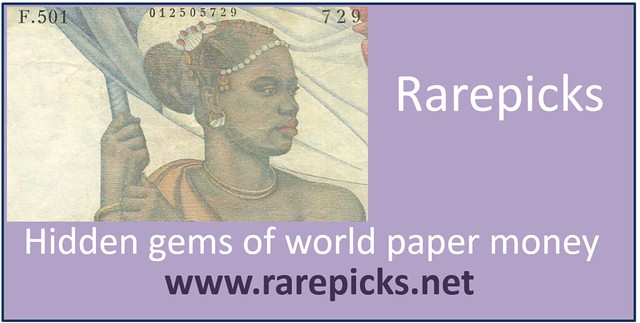
HOW WELL WE ARE FIGHTING COVID-19?
In March as we began this coronavirus journey, I published a short excerpt from an interview with my old friend Dr. Larry Brilliant, an epidemiologist who helped eradicate smallpox and has fought flu, polio, and blindness. WIRED magazine has published a follow-up interview asking his thoughts on how well we as a society have responded to the challenge. Here's a short excerpt, but be sure to read the complete article. Here's one talking head who actually knows what he's talking about. -Editor

It seems like the longer it goes, the less we know about it. Every week something new comes up that contradicts what we thought we already knew.
No, no—you know a lot more about it now than you did three months ago. Yes, there are absolutely more questions today than there were 100 days ago. But part of that is because we're getting more sophisticated in our ability to ask questions. Three months ago, we had only had a couple hundred cases of this novel virus. We have now got over 11 million cases, and a half a million deaths globally. The virus has been speeding along at an exponential speed, but so has science. So now we can begin to understand that this virus attacks the circulatory system, it attacks the vascular and nervous systems, it attacks the respiratory system, it attacks our ability to bring in oxygen. That's why people can go to the hospital and be on their phone, not in any respiratory distress, but have oxygen saturation in the 50s, which in the old days we'd think of as you're near death.
Yet you say we've made progress. How much better are my odds of survival than they were three months ago?
 Number one, you're better off because you're three months closer to a treatment or a prevention. Number two, the treatments are getting better, so the outcomes in hospitals are getting better. We already have convalescent plasma [with antibodies from recovered Covid-19 patients] that's doing an amazing job. And number three, depending on where you live, by flattening the curve, it is far less likely that you would have died in a corridor in a hospital because there was no room in an ICU, or there was no oxygen to give you. But I think now almost 100 percent of all the ICU beds in Phoenix are full.
Number one, you're better off because you're three months closer to a treatment or a prevention. Number two, the treatments are getting better, so the outcomes in hospitals are getting better. We already have convalescent plasma [with antibodies from recovered Covid-19 patients] that's doing an amazing job. And number three, depending on where you live, by flattening the curve, it is far less likely that you would have died in a corridor in a hospital because there was no room in an ICU, or there was no oxygen to give you. But I think now almost 100 percent of all the ICU beds in Phoenix are full.
OK, we know to wear a mask. But should we still be swabbing everything with Clorox?
The virus does not exist very long in fomites. I mean you're talking about a very small percentage of cases that are caused by the pencil, the toilet seat—asterisks on toilet seats, because if you don't have a cover on the toilet seat, and somebody who's got Covid takes a poop, you create an aerosol so that can spread. But if you look at the things that we worried about, like the Amazon box that comes to the door, the fact that the virus can do that doesn't mean it does do that. I don't scrub my groceries at all. If an Amazon box comes, I open it right away. I'm mostly worried about face-to-face transmission by somebody you have had a conversation with, or you're stuck in an elevator with, or you're seated next to somebody at a rock show or at a bar. I don't go do any of those things. I don't go to lectures, I don't go out.
I hear that.
Yes. Two of my friends who worked on Contagion got Covid. Ian Lipkin, who, along with me, was one of the senior scientists on the movie, was in China investigating Covid in January, and then he came back to the US under quarantine. He did not get infected in China, but he got really, really sick in New York City. He is a month and a half recovered from it. And Scott Z. Burns, who was the screenwriter for Contagion, just got out of the hospital yesterday in LA.
So is there a curse of Contagion?
That's what I said to both of them. I hope the pharaoh's curse ends with two.
To read the complete article, see:
Larry Brilliant on How Well We Are Fighting Covid-19
(https://www.wired.com/story/larry-brilliant-on-how-well-are-we-fighting-covid-19/)
To read the earlier E-Sylum article, see:
LARRY BRILLIANT, NUMISMATIC INTERNET PIONEER
(https://www.coinbooks.org/v23/esylum_v23n12a31.html)
VOCABULARY TERM: METAL CLEANING
Dick Johnson submitted this entry from his Encyclopedia of Coin and Medal Terminology. Thanks. -Editor
Metal Cleaning. Any of various methods of removing dirt, some corrosion and minute surface defects from metal; these include: abrasive blasting, acid dip, blanching, heat treating, sandblasting, shot peening, barrel tumbling, and water hone. Blanks are often metal cleaned by pickling or by one of these abrasive methods at the same time they are annealed – softened by heat treating – before striking as a customary step of metalworking. Any of these steps will produce an activated surface on the blank. This is not a problem if the striking is done within a reasonable time (up to three months) otherwise the blanks will tone before striking.
Coin blanks are annealing and cleaned at most mints prior to being upset and struck. United States mints clean and anneal all denominations and compositions except cents (which are annealed only). At U.S. mints the cleaning process is called “whitening” and where this occurs is called the “whitening room.” Use of this term is obvious, as the blanks emerge from the processing considerably lighter then beforehand.
Art medals are cleaned between multiple striking (as part of annealing) during work in process. The first step of finishing also includes some form of metal cleaning, usually abrasive blasting. Since some additional finishing will take place the activated surface caused by the abrasive blasting will be eliminated by the permanent finish on the medals.
Recent developments in metal cleaning include a vibratory bowl (using a detergent) and ultrasonic cleaning (using a solution). Both of these are nonabrasive methods, in contrast to the abrasive methods listed above. Blanks or struck pieces – at any step of the process – can be cleaned with nonabrasive methods. In this book metal cleaning is used for blank cleaning only. For the cleaning of existing coins and medals see cleaned, cleaning. See also repair and restoration.
References:
C66 {1988} Cooper pp 190-93, 240.
Looking for the meaning of a numismatic word, or the description of a term? Try the Newman Numismatic Portal's Numismatic Dictionary at: https://nnp.wustl.edu/library/dictionary
Or if you would like a printed copy of the complete Encyclopedia, it is available. There are 1,854 terms, on 678 pages, in The Encyclopedia of Coin and Medal Technology. Even running two a week would require more than 19 years to publish them all. If you would like an advance draft of this vital reference work it may be obtained from the author for your check of $50 sent postpaid. Dick Johnson, 139 Thompson Drive, Torrington, CT 06790.

ROBERT SNEIDER (1841/2-1917)
 In 1866, Robert Sneider, an engraver, established his firm Robert Sneider Company on John Street, New York City, New York.
In 1866, Robert Sneider, an engraver, established his firm Robert Sneider Company on John Street, New York City, New York.
In 1895, he purchased the firm of George Hampton Lovett. According to Dick Johnson Sneider purchased the Lovett dies of the firm and used them and the puncheons thereby confusing which medals were exclusively Sneider's own original pieces from those that are actually attributable to the Lovetts. The new location for the firm : 145 Fulton Street, New York City, New York.
After purchasing the Lovett firm Sneider became a regular advertiser in American Printer and Lithographer listed in many categories throughout each issue.
Sneider produced many bookplate for individuals and collectors prize them in their collections.
Sneider had a an advertising contract with Lewis Brodstone running a series of graphic illustrated display ads in Philatelic West. The above was scanned from the March 1903 issue.
In 1917, Robert Sneider died after 51 years of operating Robert Sneider Company. The firm had relocated at that time to 61 Fulton Street, New York City, New York. The firm continued by Zimmer after his demise. Zimmer is not listed by Dick Johnson.
To read the complete article, see:
SNEIDER, ROBERT
(http://www.numismaticmall.com/numismaticmall-com/sneider-robert)
COINS PEDIGREED TO NUMISMATIC AUTHOR A. M. SMITH
A Stack's Bowers blog article by Senior Numismatist and Cataloger Jeremy Bostwick discusses the life and collection of numismatic author A. M. Smith. -Editor
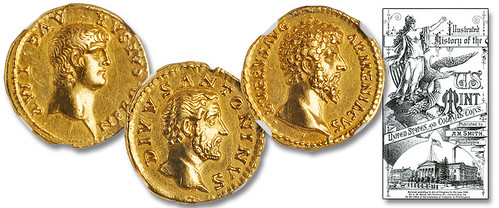
Born in Denmark in 1841, Andrew Mason (A.M.) Smith led a rather remarkable life even without his contributions to numismatics. After serving with the United States Navy in Brazil, he returned to the United States at the outbreak of the Civil War, serving two enlistments—each of which saw him wounded and honorably discharged; the second saw him cited for his bravery. He then began civilian life in the world of business, first in Salt Lake City, Utah, then in Philadelphia, Pennsylvania.
It was there, in the city of Brotherly Love, that Smith became fascinated with the U.S. Mint and numismatics. For over a decade, he dedicated a great deal of time and resources to researching and collecting, aiming to acquire specimens of gold and silver coinage not just from the United States, but from around the world and into antiquity as well. His pursuits allowed him to publish such works as History of the U.S. Mint, History of U.S. Coins, A History of Colonial Coins, and Encyclopedia of Gold and Silver Coins of the World, as well as to serve as an editor for Coin Collectors Guide and Illustrated Magazine. During this time, he even became an acquaintance of A. Loudon Snowden, nephew of former mint director James Ross Snowden, who presented him with a rather elusive gift—an 1884 Proof set in copper with all ten types struck, quarter dollar through double eagle. Tremendous rarities in the realm of patterns, this gives an idea to the expanse of Smith's magnificent collection.
Ever the go-getter, Smith later saw the prospects of the burgeoning northwest, moving his family and business to Minneapolis in 1886, where he would operate a delicatessen and liquor store—marketing it rather ingeniously—until prohibition would cause its closure at the beginning of the 1920s.
The vast majority of Smith's numismatic collection was consigned by his widow in the mid-1930s to M.H. Bolender, where specimens such as that fabled 1884 copper Proof set were offered. Today, magnificent coins bearing his pedigree continue to cross the auction block, generating a good deal of enthusiasm.
Not everything was handled through Bolender, however, as the final three remainders from his collection are featured in our August showcase auction. These three ancient coins survived the Gold Recovery Act, as they were long ago part of a brooch and considered jewelry. Despite this, they nevertheless emanate from a rather important and scholarly collection formed in the early days of the coin collecting hobby in the United States.
Gold aurei of Nero (A.D. 54-68), the deified Antoninus Pius (A.D. 139-161), and Lucius Verus (A.D. 161-169) represent the final offerings from this great American collection and can will appeal not only to seasoned veterans of ancient coins but also to collectors of United States material who may be intrigued and want to step outside and into something a bit different. Check out these crossover appeal aurei in our August sale today!
For more information on A.M. Smith's literature, please visit this 1996 exhibit entitled The Challenging Literature of A.M. Smith and hosted by the Numismatic Bibliomania Society's website.
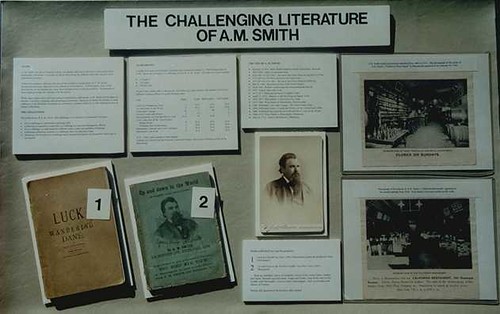
To view Pete Smith's exhibit, see:
The Challenging Literature of A.M. Smith
(https://www.coinbooks.org/about/exhibit_amsmith.html)
To read the complete article, see:
A.M. Smith—A Pioneer of American Numismatic Bibliomania
(https://www.stacksbowers.com/News/Pages/Blogs.aspx?ArticleID=american-numismatic-bibliomania)
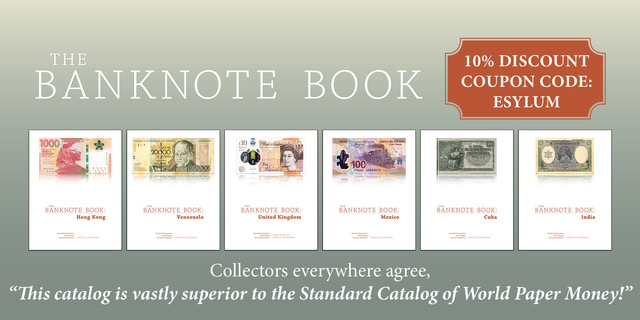
FRENCH REVOLUTION BICENTENNIAL STAMPS
While non-numismatic, this topic does have a numismatic connection - retired Bureau of Engraving portrait engraver Ken Kipperman, perhaps best known for his iconic Alexander Hamilton portrait on the $10 bill. For many years the BEP produced postage stamps for the U.S. Postal Service in addition to currency and other related printed products, and BEP engravers were also tasked to work on stamps.
First, some background. Here is a July 16, 1989 Chicago Tribune article on the French Revolution Bicentennial stamps, a series produced jointly by the U.S. and France. -Editor
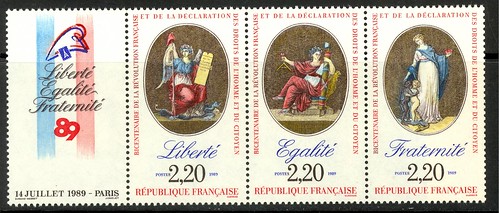
Stamps have been a means of expressing the goodwill that exists between the United States and France. The countries have issued stamps honoring each other, and both have participated in two joint issues.
A third United States joint issue was issued July 14-Bastille Day-on the 200th anniversary of the French Revolution. The United States issued a 45-cent airmail commemorative in Washington. France issued three commemoratives of the event.
The designs, as in virtually all joint issues between two or more countries, are almost identical.
 The U. S. stamp incorporates three panels with allegorical figures representing Liberty, Equality and Fraternity-the watchwords of the revolution. Printed on the stamp are "1789" in black below the allegory of Equality-the center panel-and "French Revolution" and "USAirmail" along the bottom of the design.
The U. S. stamp incorporates three panels with allegorical figures representing Liberty, Equality and Fraternity-the watchwords of the revolution. Printed on the stamp are "1789" in black below the allegory of Equality-the center panel-and "French Revolution" and "USAirmail" along the bottom of the design.
The U. S. Postal Service intentionally printed the stamp in red, silver and blue sequence to avoid any confusion with the blue, white and red, the colors of the French flag, used in the French issue.
France issued its revolution bicentennial as three individual stamps and on three different days. The stamp representing Liberty was issued March 18 in Lyon, Equality on April 22 in Ermenonville and Fraternity on May 27 in Champagney. Each stamp carried a value of 2.20 francs.
Previous joint issues were in 1983 on the bicentennial of the Treaty of Paris and in 1986 on the centennial of the dedication of the Statue of Liberty. The two countries have exchanged postal honors since as far back as 1927.
To read the complete article, see:
COMMEMORATIVES MARK FRENCH REVOLUTION
(https://www.chicagotribune.com/news/ct-xpm-1989-07-16-8902180171-story.html)
Ken explained in a phone call that the French Postal Service prepared their designs first, based on traditional allegorical representations of Liberty, Equality and Fraternity. The BEP would design closely related artwork for the USPS. In the end the engraving task was assigned to Ken.
The French had created three separate stamps; the US would combine the representations on a single stamp. One of the BEP managers in charge insisted that the US stamp designs be rendered to look like white marble statues. More about that in a minute. As noted in the Tribune article, another major difference is that the colors, intended to represent the French flag, were reversed in the US stamp.
Here's an excerpt from a June 5, 1989 New York Times article about the stamp. Collectors were noticing the differences. -Editor
Panel colors
The United States Postal Service, it seems to some collectors, cannot tell its right from its left. Others find a streak of puritanism or suggestions of racism - and all this on just one stamp.
A Postal Service official and the designer of the stamp vigorously deny all three suggestions.
The stamp, to be released July 14, Bastille Day, to mark the bicentennial of the French Revolution, shows three allegorical figures of Liberty, Equality and Fraternity, each against a colored panel. Together, the panels look like the French tricolor.
Alas and alors! The colors on the 45-cent stamp, from the left, are red, white and blue; the colors on the flag, from the left, are blue, white and red.
The Bare Breast
The suggestion of puritanism seems to be a result of the technical problems in reducing a large engraving of Fraternity, now in Musee Carnavalet in Paris, to fit in a section of a slip of paper measuring less than two square inches. The engraving shows a woman whose gown has slipped low, exposing a breast. On the stamp, the breast lacks a nipple.
"With nudity, sex and violence an integral part of our culture these days," said Dr. Bernard S. Moskow of Ridgewood, N.J., any such tampering with a stamp design "seems in the realm of the ridiculous."
"That's silly," said Ms. Parks, attributing any omission to the great reduction in size of the figure. The designer, Mr. Sheaff, said it would have been an engraver's decision whether to use the tiny, tiny dot that would have been needed.
The Black Cherub
Racism or Artistry? For the insinuations of racism, Fraternity is again the focus. In the original, and clearly visible on a similar French stamp, one of the cherubs at Fraternity's feet is white, the other black. On the American stamp, both are white.
But, Ms. Parks noted, all three figures have been redrawn in bas-relief to resemble statues, and in silver to stand out against the colored panels. Silver, she said again, not white, and without any thought of race.
To read the complete article, see:
Stamp for Bastille Day Reverses the Tricolor
(https://www.nytimes.com/1989/06/05/us/stamp-for-bastille-day-reverses-the-tricolor.html)


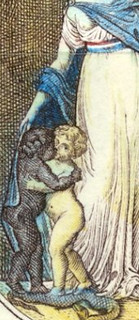 The spokesperson probably believed what she was saying, repeating what she had been told by management. But workers in the trenches saw things differently. We may never know what motivated the high-level decision to instruct the designer to use a sculptural bas-relief format, but workers immediately noticed and questioned the decision which effectively edited-out the cherub of color. Ken spoke to one of the African-American artists on staff about it - he'd certainly noticed the change as well, but decided not to get involved in the office politics. Ken took the issue to the supervisor who'd hired him, who also said he'd rather not get involved.
The spokesperson probably believed what she was saying, repeating what she had been told by management. But workers in the trenches saw things differently. We may never know what motivated the high-level decision to instruct the designer to use a sculptural bas-relief format, but workers immediately noticed and questioned the decision which effectively edited-out the cherub of color. Ken spoke to one of the African-American artists on staff about it - he'd certainly noticed the change as well, but decided not to get involved in the office politics. Ken took the issue to the supervisor who'd hired him, who also said he'd rather not get involved.
His boss told him everyone else was busy and he really needed him to do the work. Ken reluctantly agreed to do the engraving. He was faithful to the designer's artwork, right down to the nipple on the breast. But one day he came into work and found that someone else had altered the plate to remove it. Later Tom Hipschen told him he'd done the deed at the request of his supervisor.
Tom Hipschen writes:
"I had totally forgotten that. It was such a tiny thing to alter it would have taken no time at all. I was occasionally asked to work on other engraver's projects when something had to be done quickly and they were unavailable. It must have been some last-minute silliness from the Post office at a deadline. I doubt that my own superiors in the BEP would make any such changes arbitrarily."
Ken adds:
"Jack did an incredible amount of work redesigning the entire stamp.
"I took great pride in very carefully engraving the very tiny nipple not as a dot but as a-perfectly round very tiny circle."
Jack Ruther writes:
"I MODELED that stamp, I did not DESIGN, or as Ken said, redesign it. To be honest, I do not remember changing a black baby to white in preparing the model. I would think that such changes as that would have come from the Postal Service to the designer of the stamp, before it came to the BEP.
"DESIGNING means starting from scratch. We would have to research the subject and come up with one or more designs to submit to them. The Committee would then pick one for approval by the Postmaster General. If an outside artist was picked to create a design, their artwork would come through the Bureau for MODELING. Without altering the basic design, we would have to "fit" their artwork into the exact size ratios for the type of printing process it was scheduled for, and make any subtle changes that might be needed, again, for the engraving or the printing process. If we designed the stamp, we were noted as designer. In the other cases, we were the modeler.
Many thanks to Ken, Tom and Jack for sharing the background with us! The New York Times article named a Mr. Sheaff as the Designer. A web search tells me his full name is likely Richard Sheaff. Jack Ruther was the Modeler, Ken Kipperman the Engraver, and Tom Hipschen was responsible for the breast touch-up.
We may never know the full sequence of decisions and events, but the end product clearly had major differences from the French stamp designs. -Editor

NUMISMAGRAM MEDAL SELECTIONS: JULY 2020
Numismagram's Jeremy Bostwick recently added 24 lots of interesting Americana-themed medals and plaques to his website. -Editor
Jeremy writes:
"In addition to the pieces below, there are items which span America's history, ranging from the colonial period, such as an Admiral Vernon medal and a nod to the French and Indian War, to the Delaware tercentenary and modern satirical issues. Of note, there is a particular focus upon issues from the era of the Columbian expo as well as the 1904 St. Louis World's Fair. Please visit numismagram.com/inventory for all of these new additions, and check back later this month (20 July) for another group of medals and plaques centered around animal and fairy tale themes."
Harbach's Libertas Americana Token
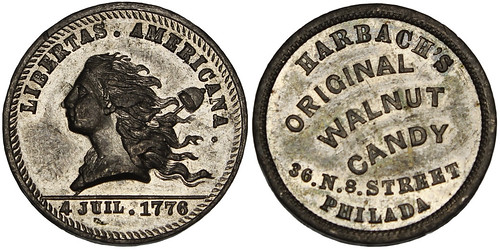
101254 | UNITED STATES. Philadelphia, Pennsylvania. Libertas Americana /Harbach's white metal Token. Issued 1876. The centennial celebration (22mm, 4.82 g, 1h). LIBERTAS AMERICANA / 4 JUIL 1776, head of liberty left, with free flowing hair and Phrygian cap on pole / HARBACH'S / ORIGINAL / WALNUT / CANDY / 36 N 8 STREET / PHILADA in six lines. Edge: Plain. Miller PA-187 var.; Rulau Pa-Ph-930B. About Uncirculated. Some light handling on the high points, with a good deal of brilliance remaining in the protected areas. Restitution issue of the popular Libertas Americana type. $245.
Designed in part by Benjamin Franklin, the popular "Libertas Americana" motif was thought of as emblematic of the fledgling, newly-established nation—wild and untamed, hopeful and, most importantly, free. Here, the allegorical Liberty exhibits free-flowing, unkempt hair, while a Phrygian cap—an ancient symbol throughout Thrace and Anatolia that later came to represent liberty—tops a pole over her shoulder. During the country's centennial celebrations in 1876, this national iconography was restituted on many tokens of medals, such as this storecard for Harbach's in Philadelphia—famous for making replicas of the Liberty Bell in their well-known walnut candy during the centennial.
Neat item - I hadn't encountered this one before. -Editor
To read the complete item description, see:
101254 | UNITED STATES. Libertas Americana/Harbach's white metal Token.
(https://www.numismagram.com/product-page/101254)
Mechanics' Institute Silver Award Medal
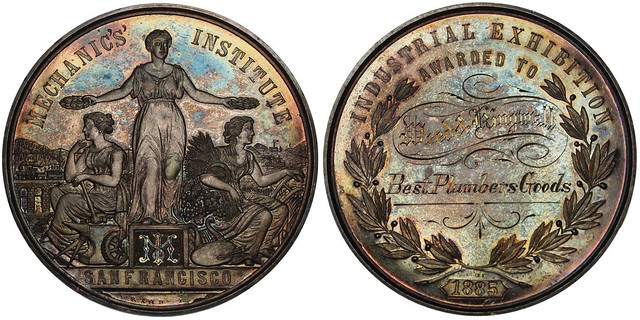
101275 | UNITED STATES. San Francisco, California. Mechanics' Institute silver Award Medal. Engraved and awarded to Weed & Kingwell in 1885. (49mm, 43.50 g, 12h). By A. Kuner. MECHANIC'S' INSTITUTE, Columbia standing facing upon base featuring "MI" (Mechanics' Institute) monogram; she presents laurel crown to personifications of industry—with hammer, anvil, gear, and compass—and of agriculture—with plow, sickle, bushel, grapes, palette, and harp; in background, locomotive crossing stone bridge and steamship sailing in the bay; SAN FRANCISCO in exergue / INDUSTRIAL EXHIBITION / AWARDED TO, Weed & Kingwell / "Best Plumbers Goods" elaborately engraved in two lines; decorative scroll work above and below; all within laurel wreath; 1885 in cartouche in exergue. Edge: Plain. Gem Mint State. Extremely brilliant and prooflike, with very colorful toning throughout. A popular series and very rare when encountered this attractive and problem free. $895.
The Mechanics' Institute in San Francisco was originally established as a vocational school for unemployed miners in 1854, just a few years after the gold rush and California statehood. Without the presence of facilities such as universities and public libraries, it served as one of the only sources by which one could attain a more advanced education in a trade. In this role, the institute was instrumental in the formation of the University of California in 1868, along with its eventual public university system. The institute is still extant, though now mostly acts in a different role, housing a vast library as well as serving as a cultural center and as a home to the oldest continually operating chess club in the United States.
No stranger to technical prizes at industrial shows, the California Brass Works—with Joseph H. Weed and Vincent Kingwell as proprietors—was established in 1851 by Gallagher & Weed and recognized as one of the leading firms in this branch of trade. Located at 125 1st Street in San Francisco, their operation is summarized by this print advertisement from the 1883 Strangers' Guide to San Francisco and Vicinity: "Manufacturers of all kinds of Brass, Composition, Zinc and Babbit Metal Castings. Church and Steamboat Bells. Also, a full assortment of Steam and Water Cocks and Valves, Hydraulic Pipes, Nozzles and Hose Couplings, etc. Brass Ship Work, Spikes, Sheathing Nails, Rudder Braces, etc. Agents for Siebert's Eureka Lubricator."
Great work - nice medal, beautifully toned. -Editor
To read the complete item description, see:
101275 | UNITED STATES. San Francisco. Mechanics' Inst. silver award Medal.
(https://www.numismagram.com/product-page/101275)
German Christopher Columbus Silver Medal
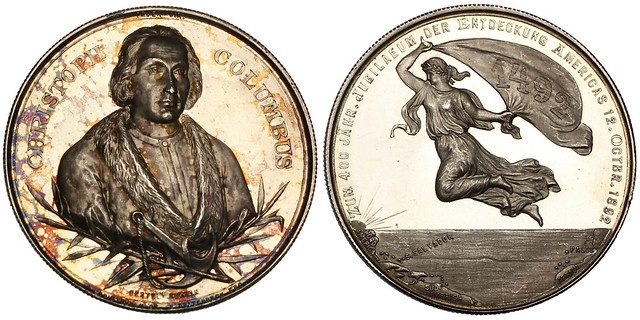
101085 | UNITED STATES & GERMANY. Christopher Columbus silver Medal. Issued 1892. Commemorating the 400th anniversary of the Columbian voyage to the New World (38mm, 19.44 g, 12h). By J. Christensen & E. Deitenbeck at O. Oertel's mint in Berlin. CHRISTOPH COLUMBUS, bust facing slightly right; wreath with anchor below / ZUM 400 JÄHR=JUBILAEUM DER ENTDECKUNG AMERICAS 12 OCTBR 1892, Fama flying right, holding banner inscribed 1492 billowing above; below, mapped horizon indicating points of the eastern and western hemispheres between which the voyage took place. Edge: Reeded. Rulau B16. Choice Mint State. Exceedingly lustrous and prooflike, with some scattered hairlines in the fields. Pleasingly toned, especially on the obverse. $285.
During the lead-up to the quadricentennial of Columbus's initial contact with the New World, numerous medals were designed and struck, both in the United States—in conjunction with the 1893 Columbian Exposition in Chicago—and abroad, sometimes for this event or for similar others. In this case, the expansive mint of Otto Oertel in Berlin produced this rather elegant type commemorating the quartercentenary.
The female figure on the reverse is stunning. A beautiful medal. Check out the higher resolution photos on Jeremy's site. -Editor
To read the complete item description, see:
101085 | UNITED STATES & GERMANY. Christopher Columbus silver Medal.
(https://www.numismagram.com/product-page/101085)
Louisiana Purchase Expo Plaque

101115 | UNITED STATES & GERMANY. St. Louis, Missouri. Louisiana Purchase International Exposition bronze award Plaque. Issued 1904. Engraved and presented to Stephan Lindeck, physicist (75x113 mm, 356 g, 12h). By P. Breuer. ARTA ARTIS VINCULA (narrow are the shackles of your craft), personification of America seated right, clasping hands with and presenting olive branch to personification of Germany seated left; "DR. STEPH LINDECK" engraved within rectangular cartouche above / ZUR ERINNERUNG / AN DEUTSCHLANDS / BETEILIGUNG AN / DER WELTAUSSTEL / LUNG IN ST. LOUIS / MCMIV (in commemoration of the German participation in the World's Fair in St. Louis) in six lines between pillars; in vignette above, World's Fair scene showing the German Pavilion and Cascade Gardens. Edge: Plain. Heidemann 1017. Mint State. Deep brown surfaces, with a hint of light rub on the high points; a darker stain is noted in the field on the obverse. Very rare. Compare to a similar piece awarded to a different individual (S. M. Felton) in Heritage 1100 (17 September 2008), lot 28283 (which realized a total of $1840 [after buyer's fee]). $865.
Billed as the Louisiana Purchase Exposition, as it commemorated the 100th anniversary of the massive land transaction between the United States and France, the fair covered an enormous area, taking visitors nearly a week to explore its offerings. 60 countries participated, one of which was the German Empire, which issued a series of plaques to be awarded to her citizens presenting or exhibiting at the fair. Among these Germans was this plaque's recipient, Dr. Stephan Lindeck, a physicist who participated in the German Educational Exhibition, specifically dealing with scientific instruments.
To read the complete item description, see:
101115 | UNITED STATES. Louisiana Purchase Int'l Expo bronze award Plaque.
(https://www.numismagram.com/product-page/101115)
Panama-Pacific International Expo Medal
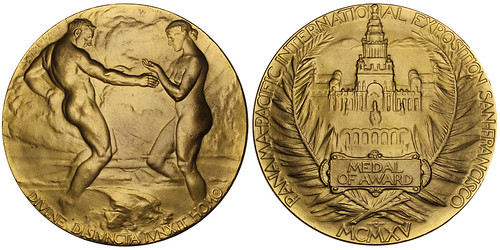
101118 | UNITED STATES. San Francisco, California. Panama-Pacific International Exposition gilt bronze award Medal. Issued 1915. Presented at the expo for the "gold" award (70mm, 132.18 g, 12h). By J. Flanagan. Nude male and female (personifications of the Atlantic and Pacific Oceans or eastern and western hemispheres) greeting one another as the sun rises over the Panama Canal in the background; DIVINE DISIVNCTA IVNXIT HOMO (the divine difference unites mankind) / PANAMA–PACIFIC INTERNATIONAL EXPOSITION SAN-FRANCISCO / MCMXV, façade of the Tower of Jewels within wreath of palm fronds; MEDAL OF AWARD in garnished cartouche below. Edge: Plain. Baxter 114; cf. Marqusee 150-152 (bronze and silvered bronze). Choice Mint State. Brilliant golden-yellow surfaces. Very rare this attractive and problem free. $945.
Designed by the famous American sculptor John Flanagan (best known in U.S. numismatics as the designer of the Washington quarter), the Panama-Pacific medal was issued as an award for many products and exhibits on display at the expo. Just 2,000 of these were struck and issued in bronze by the U.S. mint, and are now often encountered with spotting, scuffs, and other blemishes. Far fewer were issued gilt as this one, meant to serve as the "gold" prize at the expo. The elegant design features personifications of the two oceans meeting, with the Panama Canal being at their middle. The expo itself was styled as a celebration of the completion of the canal (its first use was just six months before the opening of the expo), but in a wider sense, the fair gave the world a chance to see the recovery of host city San Francisco following the devastation of the 1906 earthquake.
I love the obverse of this one. -Editor
To read the complete item description, see:
101118 | UNITED STATES. Panama-Pacific Int'l Expo gilt bronze award Medal.
(https://www.numismagram.com/product-page/101118)

PORTABLE ANTIQUITIES SCHEME HITS 1.5M OBJECTS
The British Museum's Portable Antiquities Scheme (PAS) announced a new milestone this week - 1.5 million objects have now been recorded. -Editor
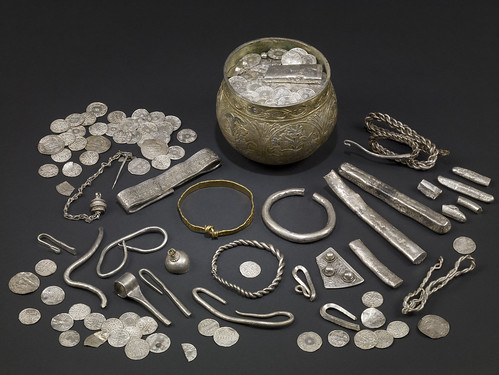
Vale of York Hoard
The British Museum's Portable Antiquities Scheme (PAS) was first set up in 1997 so that archaeological objects found by the public can be voluntarily recorded to help advance our knowledge of past. It reached 1.5 million object records on Wednesday. The item that helped cross this historic milestone was a medieval lead papal bulla (a seal for authorising papal documents, such as edicts and indulgencies) of Pope Innocent IV (r.1243-54), that was found in Shropshire.
All the discoveries on the PAS database since its inception 23 years ago have been made by members of the public. Most of them are found buried in the ground by metal detectorists. Thanks to the public's efforts, including those made through responsible metal-detecting, our understanding of past communities living in Britain over thousands of years has radically improved. Many individual finds have transformed what we know almost overnight and have become some of the most famous historical objects in the UK, such as the gold treasures of the Staffordshire Hoard.
Most objects that are unearthered are kept by the people who find them, but a number of discoveries are so important to the history of the life in Britain that they have been acquired or displayed by museums for the public to enjoy. But all the information recorded on the PAS database is freely available to anyone, and is used by students, scholars, researchers and the public alike.

Papal Bulla
To celebrate this important milestone, the British Museum with BBC History Magazine today also reveal 10 discoveries by the public and recorded on the PAS which experts have judged to have most transformed our knowledge of the past. These include a silver-gilt badge in the shape of a Boar found near the site of King Richard III's death in battle, and the discovery of thousands of Roman 'grots' – worn-down coins – which has reshaped our understanding of Roman Britain. The full list can be seen in this month's edition of BBC History magazine.
There is a large diversity amongst the 1.5 million discoveries. They range in size from vast coin hoards – the biggest was the Frome Hoard of 52,500 coins – to one-of-a-kind single pieces such as the 3,500-year-old Ringlemere Cup. The oldest items include prehistoric-worked flint from 700,000 years ago; the youngest include 20th-century military badges. Recorded finds include arrowheads, axes, beads, brooches, buckles, coins, combs, finger-rings, gaming pieces, knives, sculpture, spindle whorls, tokens and vervels.

Watlington Hoard
To read the complete press release, see:
1.5 million archaeological objects have been unearthed by the public, British Museum reveals
(https://www.britishmuseum.org/sites/default/files/2020-07/British%20Museum%20PAS%201.5m%20finds%20cc.docx)
To visit the Portable Antiquities Scheme website, see:
https://finds.org.uk/

DETECTORISTS FIND ROMAN COINS AT RACECOURSE
Metal detectorists were called in to scan a new racetrack for metal objects that might injure the racehorses. They found ancient Roman coins.
Found via The Explorator newsletter. To subscribe to Explorator, send a blank email message to: explorator+subscribe@groups.io. -Editor
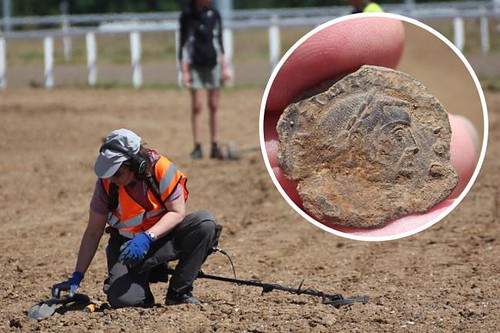
TREASURE hunters hit the jackpot when they unearthed coins dating back to Roman times at a new horse-racing circuit at Great Leighs.
Bosses at Chelmsford City Racecourse asked Braintree Metal Detecting Club to help out with the creation of the track.
Locally-sourced soil had been brought in as one of the layers for the racecourse.
The metal detectorists were brought in to search for any sharp metal objects which could potentially injure horses.
Club chairman Brian Day organised small teams to use their detectors to scour the site.
They were looking for hazards such as nails, pieces of machinery and other rubbish that could cause serious damage to racehorses' hooves.
But the enthusiasts struck gold when they also uncovered Roman and medieval coins and various pieces of jewellery.
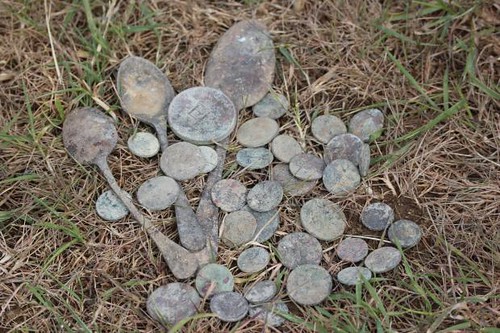
They also found hundreds of modern coins from all over the world – believed to reflect the venue's popularity with international race fans.
An astonishing amount of potentially harmful objects – including a computer keyboard – were removed.
That's not an ancient Roman keyboard of course... but I wonder what one would look like? -Editor
To read the complete article, see:
Metal detector group unearths Roman coins at racecourse
(https://www.clactonandfrintongazette.co.uk/news/north_essex_news/18564576.metal-detector-group-unearths-roman-coins-racecourse/)
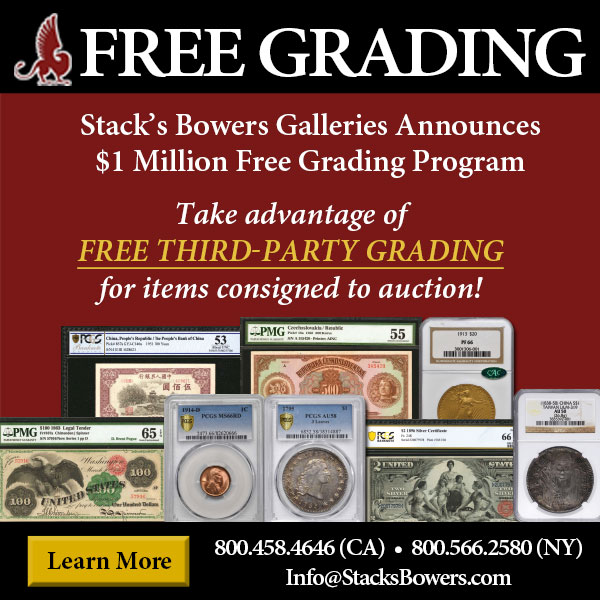
MORE ON THE AYLESBURY ABOLITION OF SLAVERY TOKEN
Here are reader responses to David Pickup's query about this token. -Editor
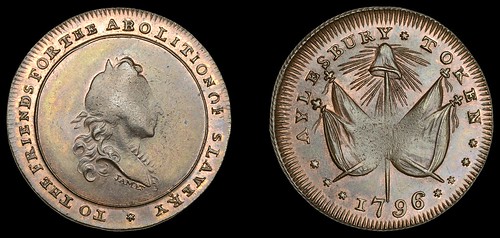
Peter Preston-Morley writes:
"I was interested to see David Pickup's contribution on the Aylesbury token in your latest E-Sylum..
As your readers who collect Conder tokens will know, the piece is not uncommon. James is the signature of the artist, Charles James, who was also responsible for the Aylesbury halfpence issued by Francis Wheeler, which bear the same date, 1796. James seems to have been a peripatetic figure, working for a number of token manufacturers in England at the time, including William Lutwyche (who coined these Aylesbury slavery abolition tokens) and Peter Skidmore.
"I wonder if the Thomas Lloyd, MA, to whom David refers is the same person recorded in 1803 as being resident at Peterley House, Great Missenden (10 miles from Aylesbury). The Clergy of Church of England Database shows that a Thomas Lloyd, MA, was licensed as a curate in Aylesbury on 21 February 1780, on a stipend of 60 GBP "plus surplice fees", advancing to Vicar on 2 February 1791, ceasing his post on 16 August 1796. A William Lloyd, DD, a former pupil of University College, Oxford and perhaps a relation, then took over as Vicar in August 1796, advancing to Rector on 6 July 1809; he died in post on 19 April 1816.
"One is tempted to ask whether, on the basis of the date on the token and the incidence of Thomas Lloyd leaving his post, something happened in Aylesbury in the summer of 1796 which links the appearance of the token to Lloyd's resignation.
"The weak definition in the centre of these tokens is a characteristic of those struck on lighter flans of circa 9 grams (Dalton & Hamer 7, 7a and 7b), whether the edge is inscribed or grained. Those on flans with plain edges (DH 7c) generally weigh circa 12-13 grams and these are almost always better struck and have tended to survive in nicer condition. I attach an image of a plain edge specimen."

Gary Groll writes:
"The token was manufactured by William Lutwyche. Not all examples have a weakness in the center; just the ones struck on thin planchets. Those struck on thicker planchets display more detail.
"The cap as displayed on the reverse is similar to the Phrygian-style cap that became a symbol of Revolutionary France. It appears on a number of 18th century British Tokens
“James” under the bust refers to Charles James, the engraver.
"I don't know why the portrait of William III was selected for this specific variant, but his likeness continued to appear on tokens throughout the 18th c token series."
Thanks, everyone. -Editor
To read the earlier E-Sylum article, see:
QUERY: AYLESBURY ABOLITION OF SLAVERY TOKEN
(https://www.coinbooks.org/v23/esylum_v23n27a17.html)
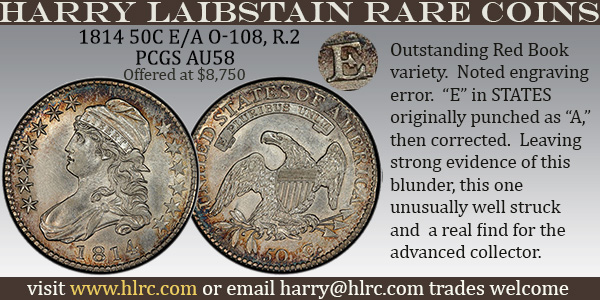
1837 R. L. BAKER SODA WATER TOKEN OFFERED
Here's the Heritage Auctions press release for a scarce early South Carolina token. -Editor

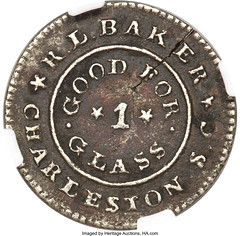
The 1837 South Carolina Merchant Token: A Pocket-Sized Piece of Americana
Long before today's world of ubiquitous soft drinks such as Coke and Pepsi, there was a thriving (but mostly forgotten) business in the United States for "soda water" during the mid-1800s. Unlike today's fizzy drinks, soda water at the time was seen as something more medicinal. It was basically just fizzy water without sweetener or flavor, but it was praised as a supposed medical panacea and sold through druggists' shops and doctors!
Heritage Auctions will be offering a great pocket-sized piece of Americana featuring a fancy urn that was intended for holding this odd beverage: an 1837 R.L. Baker Token that was struck for a Charleston, South Carolina seller of soda water. Take a look at the photos of the lot linked below, and you can even see the vapors wafting off of the urn containing this fizzy and supposedly medicinal beverage. It is a fun and campy design.
This token is famous among collectors as the very first token issued in the state of South Carolina. Tokens functioned similarly to coins and allowed you to spend these little coin-like pieces in trade with local businesses. They also helped to assuage the common and recurring problems in America during the 1800s with a lack of small change to use in commerce.
In addition to the special honor of being the first known SC token minted, these pieces are also remembered as part of the popular and beloved "Hard Times Token" series. Hard Times Tokens, or HTTs, were produced between approximately 1833 and 1844. During this period, many banks in the United States failed. The financial system in the young nation was a mess, falling on "hard times." Many tokens were created either in response to these financial issues or even to poke fun at them--many are satirical in nature.
The R. L. Baker token that Heritage is offering will be part of the August ANA Auction #1318. These pieces have great history, and they are also very desirable. Many HTTs can be purchased for under $500, but Baker tokens are so rare that they tend to sell for a few thousand dollars or so! As our catalogers explain, less than 20 are believed to have survived, so they are always popular when they come up for bid.
The bidders may "fizz" with excitement (soda water pun intended!) when this lot comes up for auction:
https://coins.ha.com/itm/hard-times-tokens/1837-rl-baker-charleston-sc-hard-times-token-environmental-damage-ngc-details-xf-low-108-ht-430-r7/p/1318-133001.s
More history here:
http://www.angelfire.com/sc2/tokenofthemonth/token015/

PENNELL'S CRUIKSHANK BANK RESTRICTION DONATION
Former American Numismatic Association museum curator Robert Hoge submitted these thoughts on a special example of the Cruikshank Bank Restriction note discussed in an earlier issue. -Editor

Concerning the posting re: George Cruikshank's Bank Restriction note, I would like to point out that thanks to the great generosity of the extraordinary collector J. Roy Pennell, Jr., the ANA Museum owns Cruikshank's original pen and ink drawing for this famous satirical piece. (It had been sketched on a sheet of paper on which the artist also drew his original images for a couple of his engravings for the first English edition of Grimm's Fairy Tales!)
This pivotal specimen was donated in a handsome Victorian album that included an original imprint of the Bank Restriction note, an example of an actual contemporary counterfeit of a Bank of England one pound note (of the kind for the passing of which Cruikshank had himself witnessed people being scandalously hanged!), and a clipping from a contemporary British newspaper giving Cruikshank's own account of the circumstances that led him to dash off and engrave this satire for the radical London publisher William Hone.
I found it very exciting, among the most evocative gifts that the ANA received during my tenure. The late Roy Pennell deserves truly great recognition for his contributions to the ANA.
That donation was a special delight for me because my great-grandparents had been particular admirers of the work of Cruikshank -- starting back during his lifetime -- and collected many of the books featuring his engravings. I had grown up knowing about him, and at one time even found in a used book shop a copy of the publication containing a collection of Hone's political offerings, which included the Bank Restriction note among them. Fun!
As it happens, I illustrated the article with the example from the ANA collection; we had earlier discussed an article about the notes in The Numismatist by the ANA's current curator Doug Mudd. Doug informs me that the Cruikshank notebook and its contents are currently on display as part of the museum's Money of Empire exhibit. Thanks! -Editor
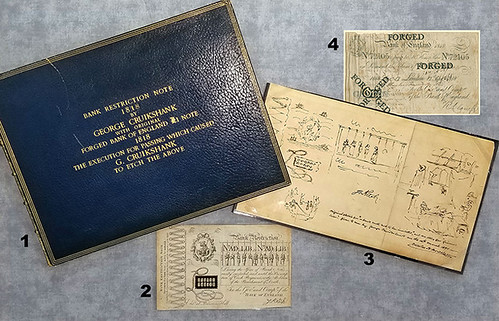
To visit Cruikshank section of the current ANA Money of Empire exhibit, see:
The Satirical Notes of George Cruikshank
(https://www.money.org/money-museum/virtual-exhibits/moe/case26)
To read the earlier E-Sylum articles, see:
GEORGE CRUIKSHANK'S NOTES
(https://www.coinbooks.org/esylum_v18n29a26.html)
THE BANK RESTRICTION NOTE OF 1819
(https://www.coinbooks.org/v23/esylum_v23n25a15.html)

NOTE HELPS AUSCHWITZ SURVIVOR TRACE LIBERATOR
Thanks to Kavan Ratnatunga for passing along this article about a WWII "Short Snorter" that helped a Holocaust survivor rediscover her American liberator. Great story. -Editor
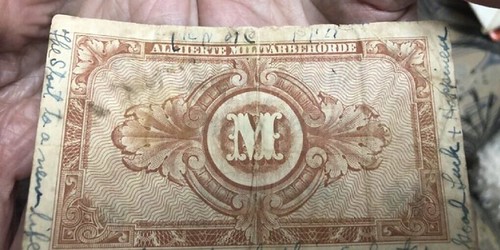
A personal message written on a German banknote 75 years ago to a Holocaust survivor has set in motion an extraordinary search for the family of its author – an American soldier who helped liberate her from a death march.
Auschwitz survivor Lily Ebert, 96, found the item while going through her possessions with her great-grandson, who is helping to document and record her story.
After the discovery, Dov Forman, 16, wrote on Twitter: “Yesterday my great-grandma showed me this bank note – given to her as a gift by a soldier who liberated her. Inscribed, it says “a start to a new life. Good luck and happiness”. Later on, she met up with those who freed her”.
His post was retweeted by the Auschwitz Museum's account to its 1 million followers, before it was shared widely, being retweeted a further two thousand times and receiving 14.5 thousand 'likes'.
Thanks to responses from around the world, the teenager found out that the note, currency issued by the US ahead of the occupation of defeated Germany, was given to his great-grandmother by Private Hayman Shulman from New Jersey.
He was an American soldier and assistant to Rabbi Herschel Schacter, who was the first US Army Chaplain to participate in the liberation of Buchenwald concentration in April 1945, and he passed away seven years ago.
Can anyone identify the note? Is this an American occupation currency piece? -Editor
To read the complete article, see:
Written message on banknote helps Auschwitz survivor trace American liberator
(https://www.cufi.org.uk/spotlight/written-message-on-banknote-helps-auschwitz-survivor-trace-american-liberator/)

BANK OF IRELAND'S NEW POLYMER £20 BANKNOTE
The Bank of Ireland has issued a new polymer banknote. -Editor
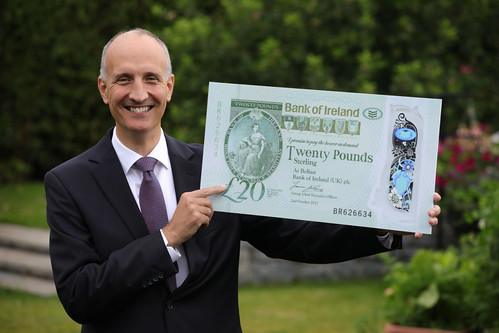
Bank of Ireland UK has announced its new polymer £20 banknote will go into circulation from 20 July.
The new £20 note retains the image of The Old Bushmills Distillery, County Antrim, the world's oldest licensed whiskey distillery.
The note incorporates enhanced security features, including a holographic stripe and a clear window. This can be seen from both the front and back of the note. The note will also include a shiny, iridescent area of ink which changes colour as you tilt it.
The £20 polymer note also incorporates a tactile feature with three arrangements of four dots in a square formation. This enables physical identification for the visually impaired.
The £20 polymer note also incorporates a tactile feature with three arrangements of four dots in a square formation. This enables physical identification for the visually impaired.
“Bank of Ireland UK remains at the forefront of banknote design technology. We have committed to polymer notes because they are cleaner, more durable, more environmentally friendly and, with enhanced features, they are more secure than ever before.
To read the complete article, see:
Bank of Ireland UK unveils new polymer £20 note
(https://www.verdict.co.uk/retail-banker-international/news/bank-of-ireland-polymer/)

COUNTERFEIT MONEY RING BUSTED IN VIETNAM
Thanks to Howard Daniel for passing this report along. -Editor

Police in the southern province of Ba Ria – Vung Tau have broken up a large-scale ring of making, storing and consuming counterfeit money that operates across several southern provinces and cities.
As many as 13 people involved in the ring have been prosecuted, of whom 12 have been arrested while a fugitive is being wanted, Colonel Le Ba Trung, head of the provincial Department of Police's security and investigation uni, said on Saturday.
All means to produce counterfeit money and nearly 400 illicit VND500,000 (US$21.6) banknotes about to enter circulation were also confiscated.
The ring was detected after police in Song Xoai Commune of Phu My Town caught red-handed Tran Anh Khoa, 28, and Huynh Thi Kim Ngoc, 25, using counterfeit money to purchase goods.
Scanning the couple on the spot, the officers discovered 200 counterfeit VND500,000 banknotes.
Khoa then confessed that he had bought the illegal banknotes online.
The provincial security and investigation police unit was able to identify the seller as Le Ngoc Hai, hailing from My An Town in Thap Muoi District in the Mekong Delta province of Dong Thap.
Hai's customers buy the counterfeit banknotes to resell to other people at the rate of VND1 million ($43) worth of real banknotes in exchange for VND2.5-5 million ($108-216) worth of fake bills.
The counterfeit money traders and consumers often carried out their transactions at grocery stores or gas stations at night.
To read the complete article, see:
Large-scale counterfeit money ring busted in southern Vietnam
(https://tuoitrenews.vn/news/society/20200704/largescale-counterfeit-money-ring-busted-in-southern-vietnam/55415.html)
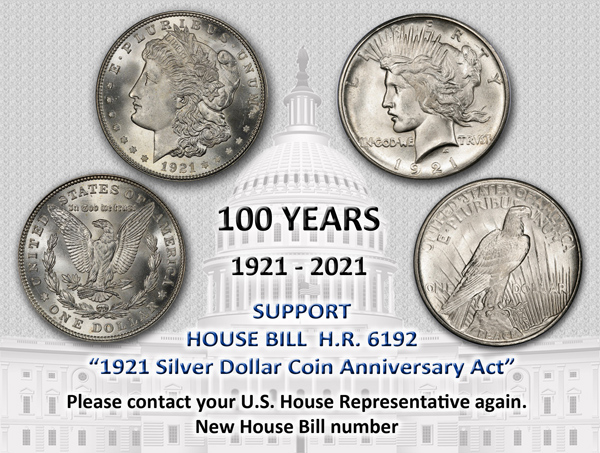
LOOSE CHANGE: JULY 12, 2020
Here are some additional items in the media this week that may be of interest. -Editor
The World's Ultimate Civilian Awards
 Here's some eye candy for collectors of Orders, Medals and Decorations.
At right is Kazakhstan's Order of the Golden Eagle.
-Editor
Here's some eye candy for collectors of Orders, Medals and Decorations.
At right is Kazakhstan's Order of the Golden Eagle.
-Editor
From simple stars to elaborate medallions, here are 12 of the world's ultimate civilian awards in all of their splendor.
To read the complete article, see:
Our Highest Honor: Top Medals From Countries Around The World
(https://www.rferl.org/a/the-top-civilian-medals-of-the-world/30659335.html)
Queen Elizabeth's Banknote Portraits
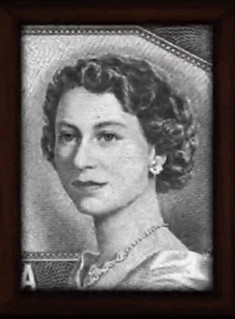 Ron Guth writes:
Ron Guth writes:
"Here's something interesting my son found on Reddit."
Thanks. It's a timelapse-style video of the Queen's portraits on paper money over her reign. Nice - check it out. -Editor
To read the complete article, see:
Queen Elizabeth's face timeline in money note
(https://www.reddit.com/r/oddlysatisfying/comments/
gykgrp/queen_elizabeths_face_timeline_in_money_note/)
Collecting Paper Napkins
Pablo Hoffman writes:
"A collection of paper napkins is the focus of this Atlas Obscura article; it may provide us food for thought on the recurrent subject of "why we collect."
Thanks. It's a great article, worth reading in its entirety. Here's an excerpt. -Editor
 It's the Icelandic predilection for museums, for turning private collections into public displays—evident in places such as Petra's Stone Collection, Sigurgeir's Bird Museum, the Icelandic Phallological Museum, and the toy museums in Akureyri, Borgarnes, and Grudafjördur, or the transportation collections, which can be found in the north and west and south. Iceland is a land of museums. It has a genius for them, in all sorts and forms.
It's the Icelandic predilection for museums, for turning private collections into public displays—evident in places such as Petra's Stone Collection, Sigurgeir's Bird Museum, the Icelandic Phallological Museum, and the toy museums in Akureyri, Borgarnes, and Grudafjördur, or the transportation collections, which can be found in the north and west and south. Iceland is a land of museums. It has a genius for them, in all sorts and forms.
As I researched my book, The Museum of Whales You Will Never See, I sat down with many collectors, curators, and directors to ask about the origins of their museums. I heard the same progression so often that I came to recognize its stages. Someone, almost accidentally, has a collection. The neighbors drop by to see. Then a community group makes an appointment. The newspaper writes something up, maybe the television news, too. And then more people come. Strangers. Tourists. Until you have to do something with all that interest, all those people dropping by. Indeed, the pattern happened often enough—private collections becoming public by degrees—that I began to think that the next one could be predicted.
So I started asking every Icelander I met: Where is there a collection big enough, known enough, visited enough, that it is in one of those stages, maybe getting close, about to tip into being a museum of its own?
There were surprisingly few leads. Almost nothing. Then in Heimaey, an island off an island, after a few calls, I was taking off my shoes to walk into a private home. In the living room: drawers and drawers of paper napkins. On the loveseat and the sofa, piles of binders overflowing with yet more napkins. The collection began in 1955. Napkins with dates printed on them went back at least to 1962. A confirmation in 1979. The end of school in 1993. A wedding in 2001. Among the napkins were a scallop-edged floral from when the collector was five years old, another in a duck pattern that matched her sister-in-law's tablecloth years ago, others from Lykil Hotel or Pizza Hut or the Military Air Transport Service of the U.S. Air Force. Flowers and fruits and angels and farms and Disney characters and Santa Claus: maybe 14,000 of them in all.
To read the complete article, see:
Why Doesn't Iceland Have a Museum of Napkins?
(https://www.atlasobscura.com/articles/iceland-museums-napkins)
Europe's Great Libraries
For cooped-up bibliophiles, here's an article on what awaits for future travel destinations. This excerpt discusses Oxford University's Bodleian Library. -Editor
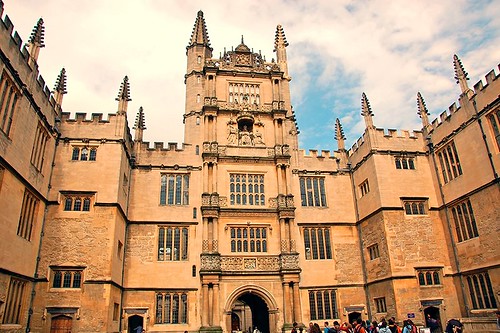
As we've had to postpone our travels because of the pandemic, I believe a weekly dose of travel dreaming can be good medicine. Here's a reminder of the fun that awaits us in Europe at the other end of this crisis.
For travelers with an interest in the evolution of Western culture, a stop at one of Europe's grand libraries is an unforgettable experience. Many of them offer the chance to connect with books and documents that changed the course of history — while basking in impressive, ornate interiors that reflect the tremendous importance of books in earlier centuries.
One of the oldest libraries in Europe is the Bodleian Library at England's Oxford University. Opened in 1602, it incorporates the older Duke Humfrey's Library from the 15th century. In those days, libraries were placed above classrooms for maximum sunlight and minimum moisture. Books were considered so precious that many were actually chained to a desk. Today this historic library is a world of creaky old shelves of books dating to the Middle Ages, stacked neatly under a beautifully painted wooden ceiling. The space is so atmospheric, it served as Hogwarts' library in the Harry Potter films. (Duke Humfrey's Library is viewable only on a popular guided tour — book in advance.)
The Weston Library, a more modern wing of the Bodleian, welcomes visitors to enjoy a gallery showcasing a changing selection of its most precious items, including a Shakespeare First Folio (18 plays from 1623), an original score of Handel's Messiah (written in 1741), and several original versions of the 1215 Magna Carta — the first legal document to set limits on a ruler's power and the basis of many modern constitutions.
To read the complete article, see:
Visiting Europe's Great Libraries
(https://www.luxurytraveladvisor.com/europe/visiting-europe-s-great-libraries)


